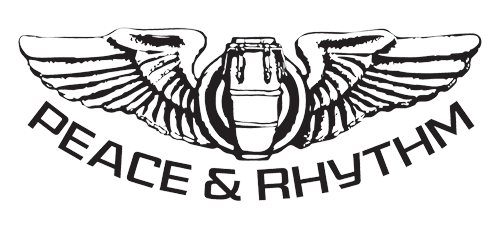News & Updates
Please note: this page is here for archival purposes only and is no longer being updated.
[
{
"id": "albert-king-april-25-1923-dec-21-1992",
"data": {
"title": "Albert King / April 25, 1923 - Dec 21, 1992",
"slug": "albert-king-april-25-1923-dec-21-1992",
"date": "2017-04-25T00:00:00.000Z"
},
"body": "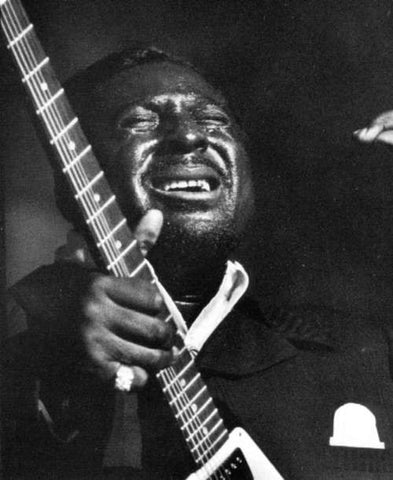\n\nHappy birthday to the great and influential bluesman **Albert King** , one of my all time favorites. I saw him play back in the '80s when I was a kid and it left a HUGE impression on me. A major guitar figure (who was a left-hander playing \"backwards\") and an excellent singer, he was born in the Mississippi Delta area. His first professional gigs were in Arkansas and he eventually moved North. Some of his earliest recordings were as a drummer for Jimmy Reed.\n\nHe had limited success in the '50s in Chicago & St Louis but really found his fame after moving to Memphis in '66, especially with the monster \"Born Under A Bad Sign\" (backed by Booker T & the MGs). Combined with a host of other great cuts for Stax, such as \"Crosscut Saw\", the rap-sampled \"Cold Feet\", \"Laundromat Blues\", \"I'll Play The Blues For You\", \"I Wanna Get Funky\" and a great version of \"Honky Tonk Woman\", Albert was a great addition to the Stax roster.\n\nAfter the label folded he made some records for the Utopia, Tomato & Fantasy labels and remained a popular live attraction on the festival circuit til his death. He joined many rock and blues superstars on stage and on recordings and his tunes were covered by many (check out the wicked Jimi Hendrix version of \"Born Under A Bad Sign\"!). His records hit the blues, R&B, funk, pop & rock spots, all while retaining his powerful string-bending.",
"filePath": "content/posts/albert-king-april-25-1923-dec-21-1992.md",
"digest": "93dc55bff4f81f31",
"rendered": {
"html": "<p><img src=\"/images/albertking1_large.jpg\" alt=\"\"></p>\n<p>Happy birthday to the great and influential bluesman <strong>Albert King</strong> , one of my all time favorites. I saw him play back in the ’80s when I was a kid and it left a HUGE impression on me. A major guitar figure (who was a left-hander playing “backwards”) and an excellent singer, he was born in the Mississippi Delta area. His first professional gigs were in Arkansas and he eventually moved North. Some of his earliest recordings were as a drummer for Jimmy Reed.</p>\n<p>He had limited success in the ’50s in Chicago & St Louis but really found his fame after moving to Memphis in ‘66, especially with the monster “Born Under A Bad Sign” (backed by Booker T & the MGs). Combined with a host of other great cuts for Stax, such as “Crosscut Saw”, the rap-sampled “Cold Feet”, “Laundromat Blues”, “I’ll Play The Blues For You”, “I Wanna Get Funky” and a great version of “Honky Tonk Woman”, Albert was a great addition to the Stax roster.</p>\n<p>After the label folded he made some records for the Utopia, Tomato & Fantasy labels and remained a popular live attraction on the festival circuit til his death. He joined many rock and blues superstars on stage and on recordings and his tunes were covered by many (check out the wicked Jimi Hendrix version of “Born Under A Bad Sign”!). His records hit the blues, R&B, funk, pop & rock spots, all while retaining his powerful string-bending.</p>",
"metadata": {
"headings": [],
"localImagePaths": [],
"remoteImagePaths": [],
"frontmatter": {
"web-scraper-order": "1746561583-258",
"web-scraper-start-url": "https://peaceandrhythm.com",
"title": "Albert King / April 25, 1923 - Dec 21, 1992",
"pagination": "https://www.peaceandrhythm.com/?page=61",
"date": "April 25, 2017",
"post": "Albert King / April 25, 1923 - Dec 21, 1992",
"post-href": "https://www.peaceandrhythm.com/blogs/news/albert-king-april-25-1923-dec-21-1992",
"slug": "albert-king-april-25-1923-dec-21-1992"
},
"imagePaths": []
}
},
"collection": "blog"
},
{
"id": "joe-henderson-april-24-1937-june-30-2001",
"data": {
"title": "Joe Henderson / April 24, 1937 - June 30, 2001",
"slug": "joe-henderson-april-24-1937-june-30-2001",
"date": "2017-04-24T00:00:00.000Z"
},
"body": "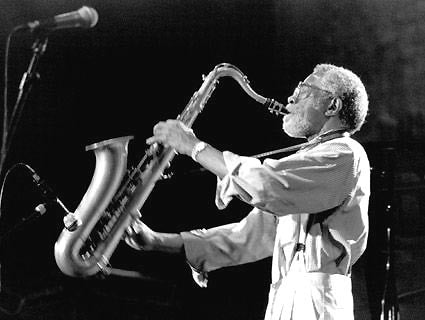\n\nThe great tenor saxophonist **Joe Henderson** came out of Wayne State University, where he was classmates with Yusef Lateef, Donald Byrd and Barry Harris. After leaving the Army in '62 he went to NYC and hooked up with Kenny Dorham & Dexter Gordon and then joined Horace Silver's group, soloing on the hit \"Song For My Father\".\n\nHe became a go-to tenor for sessions at Blue Note records (appearing with Silver, Herbie Hancock, Andrew Hill, Lee Morgan, Freddie Hubbard, Grant Green, McCoy Tyner, Larry Young and tons more), including releasing several albums on the label as a leader. In the late '60s and into the '70s he cut some more experimental and fusiony material for Milestone, including a great collaboration with Alice Coltrane.\n\nHenderson also worked with Miles Davis, Blood Sweat & Tears, Chaka Khan, Chick Corea, Olatunji, Flora Purim, Roy Ayers, Charlie Haden and a number of pop artists as an esteemed guest. He became a late career success story with Verve. Henderson had a Coltrane-inspired tenor style (and played soprano and flute as well) that worked well in many musical contexts; bop, ballads, outside, fusion, funk, Latin and pop. Some of his records were written off by purists for their dabbling in electronics and pop but time has told that they are some of the BEST experiments in those areas by a bonafide hard-bop generation player.\n\nHere's a classic from Henderson, with Trane associates Elvin Jones and McCoy Tyner (along with bassist Bob Cranshaw) in the fold. From 1965's _Inner Urge_ (Blue Note:\n\n1971's _In Pursuit Of Blackness_ (Milestone) included this selection from the same concert as the _Live at The Lighthouse_ album. Woody Shaw on trumpet:\n\nHere is Henderson in a psychedelic, overdub mindset, from _Black Is The Color_ (Milestone, '72):\n\n_Multiple_ , from 1973, is a particularly groovy one with Jack DeJohnette and James \"Blood\" Ulmer in the group:\n\nI am a big fan of his 1974 collab with Alice Coltrane and Charlie Haden, _The Elements,_ in all its' drippy, echoey glory:\n\nHere's some vintage live footage, ca. '77 or so:",
"filePath": "content/posts/joe-henderson-april-24-1937-june-30-2001.md",
"digest": "bf628bde5715e8fd",
"rendered": {
"html": "<p><img src=\"/images/89a81a862e9153154d4f813aa2757_large.jpg\" alt=\"\"></p>\n<p>The great tenor saxophonist <strong>Joe Henderson</strong> came out of Wayne State University, where he was classmates with Yusef Lateef, Donald Byrd and Barry Harris. After leaving the Army in ‘62 he went to NYC and hooked up with Kenny Dorham & Dexter Gordon and then joined Horace Silver’s group, soloing on the hit “Song For My Father”.</p>\n<p>He became a go-to tenor for sessions at Blue Note records (appearing with Silver, Herbie Hancock, Andrew Hill, Lee Morgan, Freddie Hubbard, Grant Green, McCoy Tyner, Larry Young and tons more), including releasing several albums on the label as a leader. In the late ’60s and into the ’70s he cut some more experimental and fusiony material for Milestone, including a great collaboration with Alice Coltrane.</p>\n<p>Henderson also worked with Miles Davis, Blood Sweat & Tears, Chaka Khan, Chick Corea, Olatunji, Flora Purim, Roy Ayers, Charlie Haden and a number of pop artists as an esteemed guest. He became a late career success story with Verve. Henderson had a Coltrane-inspired tenor style (and played soprano and flute as well) that worked well in many musical contexts; bop, ballads, outside, fusion, funk, Latin and pop. Some of his records were written off by purists for their dabbling in electronics and pop but time has told that they are some of the BEST experiments in those areas by a bonafide hard-bop generation player.</p>\n<p>Here’s a classic from Henderson, with Trane associates Elvin Jones and McCoy Tyner (along with bassist Bob Cranshaw) in the fold. From 1965’s <em>Inner Urge</em> (Blue Note:</p>\n<p>1971’s <em>In Pursuit Of Blackness</em> (Milestone) included this selection from the same concert as the <em>Live at The Lighthouse</em> album. Woody Shaw on trumpet:</p>\n<p>Here is Henderson in a psychedelic, overdub mindset, from <em>Black Is The Color</em> (Milestone, ‘72):</p>\n<p><em>Multiple</em> , from 1973, is a particularly groovy one with Jack DeJohnette and James “Blood” Ulmer in the group:</p>\n<p>I am a big fan of his 1974 collab with Alice Coltrane and Charlie Haden, <em>The Elements,</em> in all its’ drippy, echoey glory:</p>\n<p>Here’s some vintage live footage, ca. ‘77 or so:</p>",
"metadata": {
"headings": [],
"localImagePaths": [],
"remoteImagePaths": [],
"frontmatter": {
"web-scraper-order": "1746561578-256",
"web-scraper-start-url": "https://peaceandrhythm.com",
"title": "Joe Henderson / April 24, 1937 - June 30, 2001",
"pagination": "https://www.peaceandrhythm.com/?page=61",
"date": "April 24, 2017",
"post": "Joe Henderson / April 24, 1937 - June 30, 2001",
"post-href": "https://www.peaceandrhythm.com/blogs/news/joe-henderson-april-24-1937-june-30-2001",
"slug": "joe-henderson-april-24-1937-june-30-2001"
},
"imagePaths": []
}
},
"collection": "blog"
},
{
"id": "johnny-griffin-april-24-1928-july-25-2008",
"data": {
"title": "Johnny Griffin / April 24, 1928 - July 25, 2008",
"slug": "johnny-griffin-april-24-1928-july-25-2008",
"date": "2017-04-24T00:00:00.000Z"
},
"body": "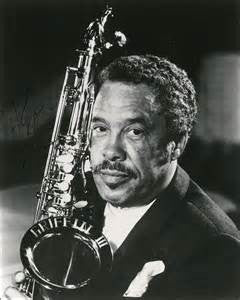\n\nThe speed metalist of the hard bop saxophone players, the tenor runs of **Johnny Griffin** could waste most competitors and his stretch in the '50s/early '60s with Blue Note, Riverside and Jazzland is hard to beat. He co-led a band with Eddie \"Lockjaw\" Davis and was a memorable feature with some of Thelonious Monk's best line-ups.\n\nHe came out of that jazz factory of Chicago's DuSable High and got early gigs with T-Bone Walker, Lionel Hampton and Arnett Cobb. He was old enough to have been part of the bop generation, despite not making a record 'til '53. He joined Art Blakey's Jazz Messengers in '57 and then filled John Coltrane's tenor seat in the Monk band, as well as participating in the incredible bop-meets-Middle Eastern experiments of Ahmed Abdul-Malik .\n\nLike Charlie Parker, he would throw quotes into his runs from a wide variety of influences and participated in saxophone battles. In '63 \"the Fastest Tenor in the West\" moved to Europe for good and was a major jazz attraction there. He worked with top European bands Clarke-Boland Big Band and with Peter Herbolzheimer, Klaus Doldinger, Passport, Martial Solal and others while also cutting some dates with Monk, Dizzy Gillespie, Wes Montgomery and Nat Adderley. He stayed in Europe until his death at 80.\n\nFrom his first Blue Note album as a leader, 1956. Max Roach on drums (\"duh!\"):\n\nGriffin works in a triple-tenor setting with Coltrane and Hank Mobley on this '57 session, also featuring Lee Morgan and Blakey. Griffin takes the first solo:\n\nAn underrated record from Riverside ('58), with Kenny Drew on piano:\n\nAnd he was a fine partner in this late '50s Eastern jazz fusion experiment led by the great Ahmed Abdul-Malik:",
"filePath": "content/posts/johnny-griffin-april-24-1928-july-25-2008.md",
"digest": "d7a6c9b57a41b84c",
"rendered": {
"html": "<p><img src=\"/images/th_e6b0594f-f9eb-4282-a003-b16f8d67aa9d_large.jpg\" alt=\"\"></p>\n<p>The speed metalist of the hard bop saxophone players, the tenor runs of <strong>Johnny Griffin</strong> could waste most competitors and his stretch in the ’50s/early ’60s with Blue Note, Riverside and Jazzland is hard to beat. He co-led a band with Eddie “Lockjaw” Davis and was a memorable feature with some of Thelonious Monk’s best line-ups.</p>\n<p>He came out of that jazz factory of Chicago’s DuSable High and got early gigs with T-Bone Walker, Lionel Hampton and Arnett Cobb. He was old enough to have been part of the bop generation, despite not making a record ‘til ‘53. He joined Art Blakey’s Jazz Messengers in ‘57 and then filled John Coltrane’s tenor seat in the Monk band, as well as participating in the incredible bop-meets-Middle Eastern experiments of Ahmed Abdul-Malik .</p>\n<p>Like Charlie Parker, he would throw quotes into his runs from a wide variety of influences and participated in saxophone battles. In ‘63 “the Fastest Tenor in the West” moved to Europe for good and was a major jazz attraction there. He worked with top European bands Clarke-Boland Big Band and with Peter Herbolzheimer, Klaus Doldinger, Passport, Martial Solal and others while also cutting some dates with Monk, Dizzy Gillespie, Wes Montgomery and Nat Adderley. He stayed in Europe until his death at 80.</p>\n<p>From his first Blue Note album as a leader, 1956. Max Roach on drums (“duh!”):</p>\n<p>Griffin works in a triple-tenor setting with Coltrane and Hank Mobley on this ‘57 session, also featuring Lee Morgan and Blakey. Griffin takes the first solo:</p>\n<p>An underrated record from Riverside (‘58), with Kenny Drew on piano:</p>\n<p>And he was a fine partner in this late ’50s Eastern jazz fusion experiment led by the great Ahmed Abdul-Malik:</p>",
"metadata": {
"headings": [],
"localImagePaths": [],
"remoteImagePaths": [],
"frontmatter": {
"web-scraper-order": "1746561580-257",
"web-scraper-start-url": "https://peaceandrhythm.com",
"title": "Johnny Griffin / April 24, 1928 - July 25, 2008",
"pagination": "https://www.peaceandrhythm.com/?page=61",
"date": "April 24, 2017",
"post": "Johnny Griffin / April 24, 1928 - July 25, 2008",
"post-href": "https://www.peaceandrhythm.com/blogs/news/johnny-griffin-april-24-1928-july-25-2008",
"slug": "johnny-griffin-april-24-1928-july-25-2008"
},
"imagePaths": []
}
},
"collection": "blog"
},
{
"id": "louis-barron-april-23-1920-nov-1-1989",
"data": {
"title": "Louis Barron / April 23, 1920 - Nov 1, 1989",
"slug": "louis-barron-april-23-1920-nov-1-1989",
"date": "2017-04-23T00:00:00.000Z"
},
"body": "**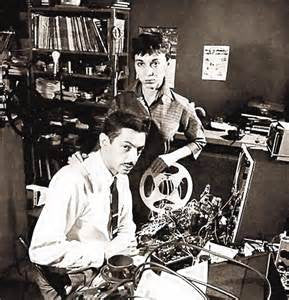**\n\n**Louis Barron** together wit his wife Bebe were early pioneers of American electronic music and created the film score for MGM's awesome 1956 Sc-Fi flick _Forbidden Planet_. The \"electronic tonalities\" of the soundtrack made it the world's first entirely electronic film score.\n\nLouis Barron was an electrician who custom-built his own circuits which the couple overloaded. They generated the sounds using a ring modulator, and they further fucked with the sounds by manipulating the tape and adding reverb, etc. They improvised along the way, trying to craft the sounds along to the actions of the characters as best they could.\n\nThe soundtrack could not be nominated for an Academy, nor could it be technically considered \"music\" by the establishment and there wasn't a soundtrack album released at the time all for the same reason: the Barrons simply did not belong to the musician's union. In fact, they were discovered by chance in a Greenwich Village nightclub and were hired immediately by an MGM producer to create sonic moods for the film. Finally, after twenty tears, the soundtrack was released on the Barrons' own Planet Records imprint.\n\nThe couple had received their first tape recorder as a wedding gift in 1947 and they became composers of _musique concréte_. Most everything created was left to electronic chance so they decided to record everything they did. There has been suggestion that the couple may have invented the tape loop. It has also been considered that their home studio, which they created in 1947, may have been the nation's first electronic music studio. They also used their tape recording machines to capture the in-studio voices of people like Aldous Huxley, Henry Miller, Tennessee Williams and Anais Nin, effectively creating audiobooks that they would release on the Barrons' own label.\n\nTheir recording business was a success, at the time only two other such services existed in NYC (one of them owned by composer Raymond Scott). Louis Barron, with his electrical expertise, built most of the studio gear, including speakers, oscillators, spring reverb and tape machines. They worked in the studio with John Cage, Morton Feldman & others. The Barrons also worked with filmmakers Maya Deren and Shirley Clarke. Sixty years later there are digital attempts at trying to achieve the sound the Barrons got with their analog process.",
"filePath": "content/posts/louis-barron-april-23-1920-nov-1-1989.md",
"digest": "d90ff91c9f089017",
"rendered": {
"html": "<p><strong><img src=\"/images/th_35fa3158-0d9a-4f50-a9dd-194363c1024e_large.jpg\" alt=\"\"></strong></p>\n<p><strong>Louis Barron</strong> together wit his wife Bebe were early pioneers of American electronic music and created the film score for MGM’s awesome 1956 Sc-Fi flick <em>Forbidden Planet</em>. The “electronic tonalities” of the soundtrack made it the world’s first entirely electronic film score.</p>\n<p>Louis Barron was an electrician who custom-built his own circuits which the couple overloaded. They generated the sounds using a ring modulator, and they further fucked with the sounds by manipulating the tape and adding reverb, etc. They improvised along the way, trying to craft the sounds along to the actions of the characters as best they could.</p>\n<p>The soundtrack could not be nominated for an Academy, nor could it be technically considered “music” by the establishment and there wasn’t a soundtrack album released at the time all for the same reason: the Barrons simply did not belong to the musician’s union. In fact, they were discovered by chance in a Greenwich Village nightclub and were hired immediately by an MGM producer to create sonic moods for the film. Finally, after twenty tears, the soundtrack was released on the Barrons’ own Planet Records imprint.</p>\n<p>The couple had received their first tape recorder as a wedding gift in 1947 and they became composers of <em>musique concréte</em>. Most everything created was left to electronic chance so they decided to record everything they did. There has been suggestion that the couple may have invented the tape loop. It has also been considered that their home studio, which they created in 1947, may have been the nation’s first electronic music studio. They also used their tape recording machines to capture the in-studio voices of people like Aldous Huxley, Henry Miller, Tennessee Williams and Anais Nin, effectively creating audiobooks that they would release on the Barrons’ own label.</p>\n<p>Their recording business was a success, at the time only two other such services existed in NYC (one of them owned by composer Raymond Scott). Louis Barron, with his electrical expertise, built most of the studio gear, including speakers, oscillators, spring reverb and tape machines. They worked in the studio with John Cage, Morton Feldman & others. The Barrons also worked with filmmakers Maya Deren and Shirley Clarke. Sixty years later there are digital attempts at trying to achieve the sound the Barrons got with their analog process.</p>",
"metadata": {
"headings": [],
"localImagePaths": [],
"remoteImagePaths": [],
"frontmatter": {
"web-scraper-order": "1746561574-255",
"web-scraper-start-url": "https://peaceandrhythm.com",
"title": "Louis Barron / April 23, 1920 - Nov 1, 1989",
"pagination": "https://www.peaceandrhythm.com/?page=61",
"date": "April 23, 2017",
"post": "Louis Barron / April 23, 1920 - Nov 1, 1989",
"post-href": "https://www.peaceandrhythm.com/blogs/news/louis-barron-april-23-1920-nov-1-1989",
"slug": "louis-barron-april-23-1920-nov-1-1989"
},
"imagePaths": []
}
},
"collection": "blog"
},
{
"id": "roy-orbison-april-23-1936-dec-6-1988",
"data": {
"title": "Roy Orbison / April 23, 1936 - Dec 6, 1988",
"slug": "roy-orbison-april-23-1936-dec-6-1988",
"date": "2017-04-23T00:00:00.000Z"
},
"body": "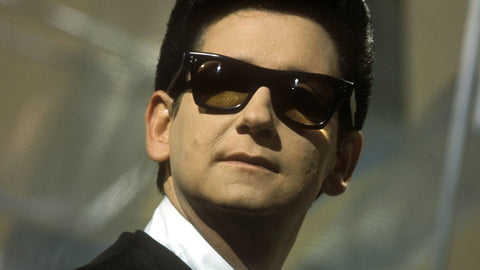\n\nOne of early rock & roll's greatest voices, **Roy Orbison** , was born 80 years ago today. Mixing country, rockabilly and pop with meticulous recording and deep lyrics with that amazing voice, there was only one Roy Orbison, the man who dressed in black with dyed black hair and dark sunglasses standing motionless on stage delivering the songs with otherworldliness.\n\nHe toured with Johnny Cash, Patsy Cline, Beatles, Rolling Stones, Beach Boys and his songs were covered by the Everly Brothers, Bruce Springsteen, Van Halen, Glenn Campbell and others. We salute you, Lefty Wilbury.",
"filePath": "content/posts/roy-orbison-april-23-1936-dec-6-1988.md",
"digest": "99c5243216f84932",
"rendered": {
"html": "<p><img src=\"/images/orbison-roy-503635210f7d1_large.jpg\" alt=\"\"></p>\n<p>One of early rock & roll’s greatest voices, <strong>Roy Orbison</strong> , was born 80 years ago today. Mixing country, rockabilly and pop with meticulous recording and deep lyrics with that amazing voice, there was only one Roy Orbison, the man who dressed in black with dyed black hair and dark sunglasses standing motionless on stage delivering the songs with otherworldliness.</p>\n<p>He toured with Johnny Cash, Patsy Cline, Beatles, Rolling Stones, Beach Boys and his songs were covered by the Everly Brothers, Bruce Springsteen, Van Halen, Glenn Campbell and others. We salute you, Lefty Wilbury.</p>",
"metadata": {
"headings": [],
"localImagePaths": [],
"remoteImagePaths": [],
"frontmatter": {
"web-scraper-order": "1746561572-254",
"web-scraper-start-url": "https://peaceandrhythm.com",
"title": "Roy Orbison / April 23, 1936 - Dec 6, 1988",
"pagination": "https://www.peaceandrhythm.com/?page=61",
"date": "April 23, 2017",
"post": "Roy Orbison / April 23, 1936 - Dec 6, 1988",
"post-href": "https://www.peaceandrhythm.com/blogs/news/roy-orbison-april-23-1936-dec-6-1988",
"slug": "roy-orbison-april-23-1936-dec-6-1988"
},
"imagePaths": []
}
},
"collection": "blog"
},
{
"id": "charles-mingus-april-22-1922-jan-5-1979",
"data": {
"title": "Charles Mingus / April 22, 1922 - Jan 5, 1979",
"slug": "charles-mingus-april-22-1922-jan-5-1979",
"date": "2017-04-22T00:00:00.000Z"
},
"body": "**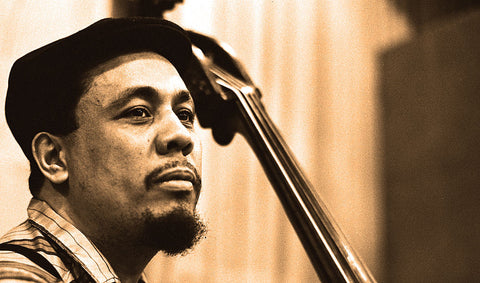**\n\n**Charles Mingus** , along with Israel \"Cachao\" Lopez and William Parker, are my favorite bassists of all time. Add that Mingus is one of the greatest composers to ever walk the planet and his notoriously prickly personality and you have a genuine one-of-a-kind icon of insane genius. Deeply bluesy, gospel-inspired, funky and experimental, his music brought \"jazz\" to a whole 'nother level. As with Duke Ellington, he wrote compositions for specific players in mind, while engaging every member of the band. His music was also deeply politicized.\n\nComing from Watts, he grew up poor but still learned the cello. He started writing progressive music pretty early in his career. He joined Buddy Collette's band a bassist and quickly got his chops. He played early on with Louis Armstrong, Chico Hamilton, Lionel Hampton and Red Norvo, even playing for a minute in the Ellington band before the Duke fired him. He then hooked up with Charlie Parker, one of his major influences.\n\nIn 1952 Mingus and Max Roach started one of the earliest musician-run record companies, Debut Records. While that label was short-lived (although highly influential) he recorded his music for a variety of bigger labels, including some prime '50s material on Atlantic and Columbia, as well as '60s classics on Candid and Impulse.\n\nHis bands nurtured talent and some top dudes played with Mingus, such as Eric Dolphy, Jackie McLean, Jaki Byard and his longtime drummer Dannie Richmond, who was a saxophonist before linking with Charles! Despite slowing a little bit in the '70s, due to physical ailments, he did continue to write and produce amazing music right til the end. His last album was supposed to be a collaboration with Joni Mitchell, whom Mingus commissioned, but he died during the making of it and she had to finish it without him.",
"filePath": "content/posts/charles-mingus-april-22-1922-jan-5-1979.md",
"digest": "a281188140f76941",
"rendered": {
"html": "<p><strong><img src=\"/images/Charles-Mingus-resize_large.jpg\" alt=\"\"></strong></p>\n<p><strong>Charles Mingus</strong> , along with Israel “Cachao” Lopez and William Parker, are my favorite bassists of all time. Add that Mingus is one of the greatest composers to ever walk the planet and his notoriously prickly personality and you have a genuine one-of-a-kind icon of insane genius. Deeply bluesy, gospel-inspired, funky and experimental, his music brought “jazz” to a whole ‘nother level. As with Duke Ellington, he wrote compositions for specific players in mind, while engaging every member of the band. His music was also deeply politicized.</p>\n<p>Coming from Watts, he grew up poor but still learned the cello. He started writing progressive music pretty early in his career. He joined Buddy Collette’s band a bassist and quickly got his chops. He played early on with Louis Armstrong, Chico Hamilton, Lionel Hampton and Red Norvo, even playing for a minute in the Ellington band before the Duke fired him. He then hooked up with Charlie Parker, one of his major influences.</p>\n<p>In 1952 Mingus and Max Roach started one of the earliest musician-run record companies, Debut Records. While that label was short-lived (although highly influential) he recorded his music for a variety of bigger labels, including some prime ’50s material on Atlantic and Columbia, as well as ’60s classics on Candid and Impulse.</p>\n<p>His bands nurtured talent and some top dudes played with Mingus, such as Eric Dolphy, Jackie McLean, Jaki Byard and his longtime drummer Dannie Richmond, who was a saxophonist before linking with Charles! Despite slowing a little bit in the ’70s, due to physical ailments, he did continue to write and produce amazing music right til the end. His last album was supposed to be a collaboration with Joni Mitchell, whom Mingus commissioned, but he died during the making of it and she had to finish it without him.</p>",
"metadata": {
"headings": [],
"localImagePaths": [],
"remoteImagePaths": [],
"frontmatter": {
"web-scraper-order": "1746561570-253",
"web-scraper-start-url": "https://peaceandrhythm.com",
"title": "Charles Mingus / April 22, 1922 - Jan 5, 1979",
"pagination": "https://www.peaceandrhythm.com/?page=62",
"date": "April 22, 2017",
"post": "Charles Mingus / April 22, 1922 - Jan 5, 1979",
"post-href": "https://www.peaceandrhythm.com/blogs/news/charles-mingus-april-22-1922-jan-5-1979",
"slug": "charles-mingus-april-22-1922-jan-5-1979"
},
"imagePaths": []
}
},
"collection": "blog"
},
{
"id": "joe-cuba-aoril-22-1931-feb-15-2009",
"data": {
"title": "Joe Cuba / Aoril 22, 1931 - Feb 15, 2009",
"slug": "joe-cuba-aoril-22-1931-feb-15-2009",
"date": "2017-04-22T00:00:00.000Z"
},
"body": "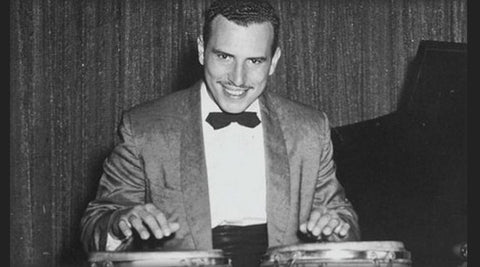\n\nDespite the working name of \"**Joe Cuba** \", the conguero Gilberto Calderon was actually a Nuyorican who grew up in Spanish Harlem. Since the first album in 1962 and into the '70s, the Joe Cuba Sextet were a very important and influential band on the newer generation of Latino musicians. With the two-tongued vocal duo of Cheo Feliciano (singing in Español) and Jimmy Sabater (singing in English) they scored a bunch of smash hits and helped fuel the boogaloo craze of the mid-'60s, fusing the soul music influence with Afro-Cuban rhythms. The group's albums contained burning hot descargas, jumping boogaloos and some humorous lyrics. \"Bang Bang\" is about as big a pop hit as Latin music has ever had and is one of the most covered songs from the scene.",
"filePath": "content/posts/joe-cuba-aoril-22-1931-feb-15-2009.md",
"digest": "7d3d74f5276cd5b1",
"rendered": {
"html": "<p><img src=\"/images/Joe-Cuba1_large.jpg\" alt=\"\"></p>\n<p>Despite the working name of “<strong>Joe Cuba</strong> ”, the conguero Gilberto Calderon was actually a Nuyorican who grew up in Spanish Harlem. Since the first album in 1962 and into the ’70s, the Joe Cuba Sextet were a very important and influential band on the newer generation of Latino musicians. With the two-tongued vocal duo of Cheo Feliciano (singing in Español) and Jimmy Sabater (singing in English) they scored a bunch of smash hits and helped fuel the boogaloo craze of the mid-’60s, fusing the soul music influence with Afro-Cuban rhythms. The group’s albums contained burning hot descargas, jumping boogaloos and some humorous lyrics. “Bang Bang” is about as big a pop hit as Latin music has ever had and is one of the most covered songs from the scene.</p>",
"metadata": {
"headings": [],
"localImagePaths": [],
"remoteImagePaths": [],
"frontmatter": {
"web-scraper-order": "1746561568-252",
"web-scraper-start-url": "https://peaceandrhythm.com",
"title": "Joe Cuba / Aoril 22, 1931 - Feb 15, 2009",
"pagination": "https://www.peaceandrhythm.com/?page=62",
"date": "April 22, 2017",
"post": "Joe Cuba / Aoril 22, 1931 - Feb 15, 2009",
"post-href": "https://www.peaceandrhythm.com/blogs/news/joe-cuba-aoril-22-1931-feb-15-2009",
"slug": "joe-cuba-aoril-22-1931-feb-15-2009"
},
"imagePaths": []
}
},
"collection": "blog"
},
{
"id": "paul-chambers-april-22-1935-jan-4-1969",
"data": {
"title": "Paul Chambers / April 22, 1935 - Jan 4, 1969",
"slug": "paul-chambers-april-22-1935-jan-4-1969",
"date": "2017-04-22T00:00:00.000Z"
},
"body": "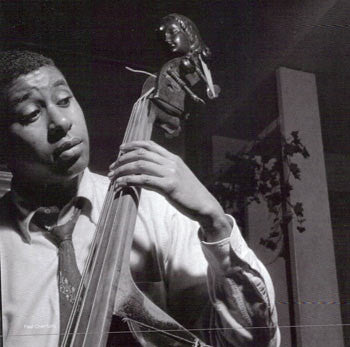\n\nThe great jazz bass virtuoso **Paul Chambers** , forever immortalized by his old pal John Coltrane as \"Mr PC\", brought the instrument to a new level in his very short time on the planet. He was an early popularizer of the bowing technique and contributed greatly to harmonic advancement for the instrument.\n\nBorn in Pittsburgh and raised in Detroit, Chambers played brass instruments before switching to bass at 14. He quickly started playing classical music while still in high school, as well as jazz with Barry Harris before moving to NYC in the mid-'50s. He held a regular gig with Miles Davis for eight years (that's his bassline that is burned into your head at the beginning of \"Kind of Blue\").\n\nAfter Miles he worked with Wynton Kelly for the rest of his years, while also cutting a lot of sessions. He played on albums by Coltrane, Thelonious Monk, Art Pepper, Wayne Shorter, Wes Montgomery, Oliver Nelson, Cannonball Adderly, Sonny Rollins, Bud Powell, Lee Morgan, Herbie Hancock, Hank Mobley, King Curtis, Johnny Griffin and about a million others before his early death at 33. A popular fellow in the jazz community, there are no fewer than five compositions named after him, including of course the famous \"Mr PC\", a tune that my old hardcore band used to play.",
"filePath": "content/posts/paul-chambers-april-22-1935-jan-4-1969.md",
"digest": "ec7061154d870108",
"rendered": {
"html": "<p><img src=\"/images/paul-chambers_large.jpg\" alt=\"\"></p>\n<p>The great jazz bass virtuoso <strong>Paul Chambers</strong> , forever immortalized by his old pal John Coltrane as “Mr PC”, brought the instrument to a new level in his very short time on the planet. He was an early popularizer of the bowing technique and contributed greatly to harmonic advancement for the instrument.</p>\n<p>Born in Pittsburgh and raised in Detroit, Chambers played brass instruments before switching to bass at 14. He quickly started playing classical music while still in high school, as well as jazz with Barry Harris before moving to NYC in the mid-’50s. He held a regular gig with Miles Davis for eight years (that’s his bassline that is burned into your head at the beginning of “Kind of Blue”).</p>\n<p>After Miles he worked with Wynton Kelly for the rest of his years, while also cutting a lot of sessions. He played on albums by Coltrane, Thelonious Monk, Art Pepper, Wayne Shorter, Wes Montgomery, Oliver Nelson, Cannonball Adderly, Sonny Rollins, Bud Powell, Lee Morgan, Herbie Hancock, Hank Mobley, King Curtis, Johnny Griffin and about a million others before his early death at 33. A popular fellow in the jazz community, there are no fewer than five compositions named after him, including of course the famous “Mr PC”, a tune that my old hardcore band used to play.</p>",
"metadata": {
"headings": [],
"localImagePaths": [],
"remoteImagePaths": [],
"frontmatter": {
"web-scraper-order": "1746561565-251",
"web-scraper-start-url": "https://peaceandrhythm.com",
"title": "Paul Chambers / April 22, 1935 - Jan 4, 1969",
"pagination": "https://www.peaceandrhythm.com/?page=62",
"date": "April 22, 2017",
"post": "Paul Chambers / April 22, 1935 - Jan 4, 1969",
"post-href": "https://www.peaceandrhythm.com/blogs/news/paul-chambers-april-22-1935-jan-4-1969",
"slug": "paul-chambers-april-22-1935-jan-4-1969"
},
"imagePaths": []
}
},
"collection": "blog"
},
{
"id": "peter-kowald-april-21-1944-sept-21-2002",
"data": {
"title": "Peter Kowald / April 21, 1944 - Sept 21, 2002",
"slug": "peter-kowald-april-21-1944-sept-21-2002",
"date": "2017-04-21T00:00:00.000Z"
},
"body": "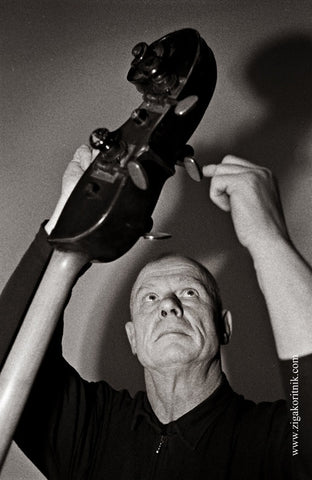\n\nA favorite of many on the instrument, the much-missed **Peter Kowald** was a major league improvising bassist. He was a member of Globe Unity Orchestra, Cooperative Trio, his \"world music\" project Global Village, London Jazz Composers Orchestra, Schlippenbach Trio and many others.\n\nA native of Germany, he started playing in 1960 and he and Peter Brotzmann hooked up for some racket shortly thereafter. They started touring in '66 with Carla Bley & Mike Mantler. He had a longtime association with Globe Unity, recording several records with them. He sometimes composed for and conducted that wild big band.\n\nAside from his life-long work and friendship with Brotzmann (and several of his formations) he also played with many, many leading figures from the experimental and improvising music world: William Parker, Diamanda Galas, Cecil Taylor, my old neighbor Chris Corsano, Evan Parker, Butch Morris, Rashied Ali, Sainkho Namtchylak, Bill Dixon, Fred Anderson, Wadada Leo Smith, Joe McPhee, Trilok Gurtu, Tom Cora and Fred Anderson are just a few.\n\nHe performed and recorded solo bass projects, duos with bassists and other musicians, as well as working with poets, dancers, vocalists and in several large multinational improvising orchestras. He also played tuba. He died in the arms and home of William Parker. Witnessing a live solo bass performance by Peter Kowald was invigorating and exciting and I was fortunate to have been there.\n\nPeter in quartet with Charles Gayle, Marilyn Crispell and Rashied Ali in NYC:",
"filePath": "content/posts/peter-kowald-april-21-1944-sept-21-2002.md",
"digest": "5d81f996b4c9dcb8",
"rendered": {
"html": "<p><img src=\"/images/bf17acabea2cb5357c21a6fd018f6ef0_large.jpg\" alt=\"\"></p>\n<p>A favorite of many on the instrument, the much-missed <strong>Peter Kowald</strong> was a major league improvising bassist. He was a member of Globe Unity Orchestra, Cooperative Trio, his “world music” project Global Village, London Jazz Composers Orchestra, Schlippenbach Trio and many others.</p>\n<p>A native of Germany, he started playing in 1960 and he and Peter Brotzmann hooked up for some racket shortly thereafter. They started touring in ‘66 with Carla Bley & Mike Mantler. He had a longtime association with Globe Unity, recording several records with them. He sometimes composed for and conducted that wild big band.</p>\n<p>Aside from his life-long work and friendship with Brotzmann (and several of his formations) he also played with many, many leading figures from the experimental and improvising music world: William Parker, Diamanda Galas, Cecil Taylor, my old neighbor Chris Corsano, Evan Parker, Butch Morris, Rashied Ali, Sainkho Namtchylak, Bill Dixon, Fred Anderson, Wadada Leo Smith, Joe McPhee, Trilok Gurtu, Tom Cora and Fred Anderson are just a few.</p>\n<p>He performed and recorded solo bass projects, duos with bassists and other musicians, as well as working with poets, dancers, vocalists and in several large multinational improvising orchestras. He also played tuba. He died in the arms and home of William Parker. Witnessing a live solo bass performance by Peter Kowald was invigorating and exciting and I was fortunate to have been there.</p>\n<p>Peter in quartet with Charles Gayle, Marilyn Crispell and Rashied Ali in NYC:</p>",
"metadata": {
"headings": [],
"localImagePaths": [],
"remoteImagePaths": [],
"frontmatter": {
"web-scraper-order": "1746561563-250",
"web-scraper-start-url": "https://peaceandrhythm.com",
"title": "Peter Kowald / April 21, 1944 - Sept 21, 2002",
"pagination": "https://www.peaceandrhythm.com/?page=62",
"date": "April 21, 2017",
"post": "Peter Kowald / April 21, 1944 - Sept 21, 2002",
"post-href": "https://www.peaceandrhythm.com/blogs/news/peter-kowald-april-21-1944-sept-21-2002",
"slug": "peter-kowald-april-21-1944-sept-21-2002"
},
"imagePaths": []
}
},
"collection": "blog"
},
{
"id": "beaver-harris-april-20-1936-dec-22-1991",
"data": {
"title": "Beaver Harris / April 20, 1936 - Dec 22, 1991",
"slug": "beaver-harris-april-20-1936-dec-22-1991",
"date": "2017-04-20T00:00:00.000Z"
},
"body": "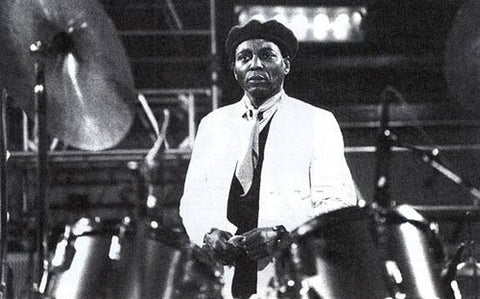\n\nOne of the heaviest drummers in jazz, William **\"Beaver\" Harris** came out of a baseball family in Pittsburgh (in fact, his father was a founder of the Negro Leagues Pittsburgh team and two of Harris' uncles were pro players as well). A teenaged Beaver played professionally at 3B for the Negro League's Kansas City Monarchs, New York Black Yankees and Indianapolis Clowns.\n\nAfter playing reed instruments as a child he started playing drums while in the military at 20. While stationed at Fort Knox, he played in a band with Albert Ayler and Stanley Turrentine. After discharge he was playing gigs around Pittsburgh when Max Roach encouraged him to move to NYC, which he did in '62, first working with Sonny Rollins and then joining Archie Shepp in '65, touring and recording 17 albums with Shepp. In '66 & '67 he reunited with Ayler, touring Europe and playing on four albums with his band.\n\nDuring the '60s he also played with Marion Brown, Roswell Rudd, Thelonious Monk (although he was the only drummer Monk ever fired!), Dexter Gordon, the Jazz Composers Orchestra and others. In '68 he started the 360 Degree Music Experience (with Grachan Moncur III, Roland Alexander, Dave Burrell and Ron Carter, and even featured a steel drummer at times). This group aimed to combine world rhythms with jazz and other black music forms. He played with the great Cecil Taylor during the '70s, as well as with Gato Barbieri, Ken McIntyre, Steve Lacy and in a quintet with Chet Baker, Keith Jarrett, Charlie Haden and Lee Konitz .\n\nAround the late '70s/early '80s he played in the improv punk/noise/no wave band The Blue Humans (with Rudolph Grey). In the '80s he worked extensively with guitarist Larry Coryell. His last group was a trio with Barry Harris (no relation) and Ron Carter before his untimely 1991 death from prostate cancer.\n\nHere's something from his classic album _From Ragtime To No Time_ , 1975:\n\nBeaver's ensemble on a calypso-jazz vibe:\n\nHere's Beaver playing with that incredible group Ayler brought to Europe in '66:\n\n Beaver with Shepp, ca '68:",
"filePath": "content/posts/beaver-harris-april-20-1936-dec-22-1991.md",
"digest": "57d4d03fed8adeda",
"rendered": {
"html": "<p><img src=\"/images/beaver_large.jpg\" alt=\"\"></p>\n<p>One of the heaviest drummers in jazz, William <strong>“Beaver” Harris</strong> came out of a baseball family in Pittsburgh (in fact, his father was a founder of the Negro Leagues Pittsburgh team and two of Harris’ uncles were pro players as well). A teenaged Beaver played professionally at 3B for the Negro League’s Kansas City Monarchs, New York Black Yankees and Indianapolis Clowns.</p>\n<p>After playing reed instruments as a child he started playing drums while in the military at 20. While stationed at Fort Knox, he played in a band with Albert Ayler and Stanley Turrentine. After discharge he was playing gigs around Pittsburgh when Max Roach encouraged him to move to NYC, which he did in ‘62, first working with Sonny Rollins and then joining Archie Shepp in ‘65, touring and recording 17 albums with Shepp. In ‘66 & ‘67 he reunited with Ayler, touring Europe and playing on four albums with his band.</p>\n<p>During the ’60s he also played with Marion Brown, Roswell Rudd, Thelonious Monk (although he was the only drummer Monk ever fired!), Dexter Gordon, the Jazz Composers Orchestra and others. In ‘68 he started the 360 Degree Music Experience (with Grachan Moncur III, Roland Alexander, Dave Burrell and Ron Carter, and even featured a steel drummer at times). This group aimed to combine world rhythms with jazz and other black music forms. He played with the great Cecil Taylor during the ’70s, as well as with Gato Barbieri, Ken McIntyre, Steve Lacy and in a quintet with Chet Baker, Keith Jarrett, Charlie Haden and Lee Konitz .</p>\n<p>Around the late ’70s/early ’80s he played in the improv punk/noise/no wave band The Blue Humans (with Rudolph Grey). In the ’80s he worked extensively with guitarist Larry Coryell. His last group was a trio with Barry Harris (no relation) and Ron Carter before his untimely 1991 death from prostate cancer.</p>\n<p>Here’s something from his classic album <em>From Ragtime To No Time</em> , 1975:</p>\n<p>Beaver’s ensemble on a calypso-jazz vibe:</p>\n<p>Here’s Beaver playing with that incredible group Ayler brought to Europe in ‘66:</p>\n<p>Beaver with Shepp, ca ‘68:</p>",
"metadata": {
"headings": [],
"localImagePaths": [],
"remoteImagePaths": [],
"frontmatter": {
"web-scraper-order": "1746561555-248",
"web-scraper-start-url": "https://peaceandrhythm.com",
"title": "Beaver Harris / April 20, 1936 - Dec 22, 1991",
"pagination": "https://www.peaceandrhythm.com/?page=63",
"date": "April 20, 2017",
"post": "Beaver Harris / April 20, 1936 - Dec 22, 1991",
"post-href": "https://www.peaceandrhythm.com/blogs/news/beaver-harris-april-20-1936-dec-22-1991",
"slug": "beaver-harris-april-20-1936-dec-22-1991"
},
"imagePaths": []
}
},
"collection": "blog"
},
{
"id": "lionel-hampton-april-20-1908-aug-31-2002",
"data": {
"title": "Lionel Hampton / April 20, 1908 - Aug 31, 2002",
"slug": "lionel-hampton-april-20-1908-aug-31-2002",
"date": "2017-04-20T00:00:00.000Z"
},
"body": "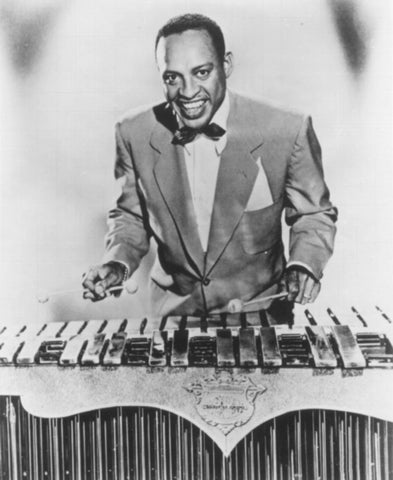\n\nThe great jazz vibraphonist & popular bandleader **Lionel Hampton** came out of Chicago and was a kit drummer before switching to a newly created instrument, the vibraphone, of which Hamp became the instrument's first star, his first gig on it being with Louie Armstrong in 1930.\n\nIn the late '30s he played in the Benny Goodman Orchestra (one of the few racially integrated ensembles of the time) and Quartet (Hamp, BG, Teddy Wilson, Gene Krupa) before starting his own orchestra in 1940. That band became one of the most popular bands of the '40s and '50s, playing jazz, R&B and pop. It functioned as training ground for several great musicians, including Charles Mingus, Johnny Griffin, Wes Montgomery and more.\n\nHamp toured the world, made some TV appearances and was hugely popular through the '50s. In the '70s he founded his own record label and continued playing into the '90s until a stroke disabled him. He was involved in political causes and was a thirty-third degree Freemason. He is buried in Woodlawn Cemetary, right next to Miles Davis and Duke Ellington.",
"filePath": "content/posts/lionel-hampton-april-20-1908-aug-31-2002.md",
"digest": "4f562bc1a54cd7c6",
"rendered": {
"html": "<p><img src=\"/images/p55322co33n_large.jpg\" alt=\"\"></p>\n<p>The great jazz vibraphonist & popular bandleader <strong>Lionel Hampton</strong> came out of Chicago and was a kit drummer before switching to a newly created instrument, the vibraphone, of which Hamp became the instrument’s first star, his first gig on it being with Louie Armstrong in 1930.</p>\n<p>In the late ’30s he played in the Benny Goodman Orchestra (one of the few racially integrated ensembles of the time) and Quartet (Hamp, BG, Teddy Wilson, Gene Krupa) before starting his own orchestra in 1940. That band became one of the most popular bands of the ’40s and ’50s, playing jazz, R&B and pop. It functioned as training ground for several great musicians, including Charles Mingus, Johnny Griffin, Wes Montgomery and more.</p>\n<p>Hamp toured the world, made some TV appearances and was hugely popular through the ’50s. In the ’70s he founded his own record label and continued playing into the ’90s until a stroke disabled him. He was involved in political causes and was a thirty-third degree Freemason. He is buried in Woodlawn Cemetary, right next to Miles Davis and Duke Ellington.</p>",
"metadata": {
"headings": [],
"localImagePaths": [],
"remoteImagePaths": [],
"frontmatter": {
"web-scraper-order": "1746561553-247",
"web-scraper-start-url": "https://peaceandrhythm.com",
"title": "Lionel Hampton / April 20, 1908 - Aug 31, 2002",
"pagination": "https://www.peaceandrhythm.com/?page=63",
"date": "April 20, 2017",
"post": "Lionel Hampton / April 20, 1908 - Aug 31, 2002",
"post-href": "https://www.peaceandrhythm.com/blogs/news/lionel-hampton-april-20-1908-aug-31-2002",
"slug": "lionel-hampton-april-20-1908-aug-31-2002"
},
"imagePaths": []
}
},
"collection": "blog"
},
{
"id": "tito-puente-april-20-1923-june-1-2000",
"data": {
"title": "Tito Puente / April 20, 1923 - June 1, 2000",
"slug": "tito-puente-april-20-1923-june-1-2000",
"date": "2017-04-20T00:00:00.000Z"
},
"body": "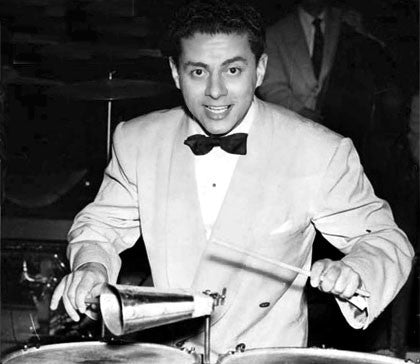\n\nHappy 4/20 birthday shout-out to the iconic **Tito Puente**! Best known as a Simpsons charact...haha just kidding! Among the Nuyorican musical greats, there has never been a dull moment with El Rey's brand of fiery and entertaining Latin jazz. His first notable pro gig was with Machito during WW2, before serving his own tour. After receiving medals as a \"war hero\" he started a nonet, The Piccadilly Boys, in '47. He led one of the great orchestras of the classic mambo era, often featuring percussion battles with Tito and top players on the scene.\n\nIn 1960, his band was just the second Latin orchestra to ever tour Japan. In the late '60s his song \"Oye Como Va\" was covered to much acclaim by the Santana band. He was a great composer in his own right, but also tastefully covered other tunes from jazz standards to rock & pop, including songs by Thelonious Monk, Santana (returning the favor!), Tommy James and others. His instrumental arsenal included timbales, congas, bongos, trap drums, vibraphone, marimba, piano and even saxophone. He was also a producer for several vocalists and musicians (including La Lupe). He has played with Dizzy Gillespie, Sonny Stitt, Eddie Palmieri, Phil Woods and on the Nuyorican Soul project.\n\nThe notoriously flamboyant showman was also a restaurateur. He covered a lot of musical ground in his career: mambo, jazz, Afro-Cuban, salsa, son, boleros, cha cha cha, boogaloo, bossa nova, fusion and pop. He was also a Santeria priest.",
"filePath": "content/posts/tito-puente-april-20-1923-june-1-2000.md",
"digest": "1bb63bc4d6b1f929",
"rendered": {
"html": "<p><img src=\"/images/puente_tito_3_large.jpg\" alt=\"\"></p>\n<p>Happy 4/20 birthday shout-out to the iconic <strong>Tito Puente</strong>! Best known as a Simpsons charact…haha just kidding! Among the Nuyorican musical greats, there has never been a dull moment with El Rey’s brand of fiery and entertaining Latin jazz. His first notable pro gig was with Machito during WW2, before serving his own tour. After receiving medals as a “war hero” he started a nonet, The Piccadilly Boys, in ‘47. He led one of the great orchestras of the classic mambo era, often featuring percussion battles with Tito and top players on the scene.</p>\n<p>In 1960, his band was just the second Latin orchestra to ever tour Japan. In the late ’60s his song “Oye Como Va” was covered to much acclaim by the Santana band. He was a great composer in his own right, but also tastefully covered other tunes from jazz standards to rock & pop, including songs by Thelonious Monk, Santana (returning the favor!), Tommy James and others. His instrumental arsenal included timbales, congas, bongos, trap drums, vibraphone, marimba, piano and even saxophone. He was also a producer for several vocalists and musicians (including La Lupe). He has played with Dizzy Gillespie, Sonny Stitt, Eddie Palmieri, Phil Woods and on the Nuyorican Soul project.</p>\n<p>The notoriously flamboyant showman was also a restaurateur. He covered a lot of musical ground in his career: mambo, jazz, Afro-Cuban, salsa, son, boleros, cha cha cha, boogaloo, bossa nova, fusion and pop. He was also a Santeria priest.</p>",
"metadata": {
"headings": [],
"localImagePaths": [],
"remoteImagePaths": [],
"frontmatter": {
"web-scraper-order": "1746561561-249",
"web-scraper-start-url": "https://peaceandrhythm.com",
"title": "Tito Puente / April 20, 1923 - June 1, 2000",
"pagination": "https://www.peaceandrhythm.com/?page=62",
"date": "April 20, 2017",
"post": "Tito Puente / April 20, 1923 - June 1, 2000",
"post-href": "https://www.peaceandrhythm.com/blogs/news/tito-puente-april-20-1923-june-1-2000",
"slug": "tito-puente-april-20-1923-june-1-2000"
},
"imagePaths": []
}
},
"collection": "blog"
},
{
"id": "alexis-korner-april-19-1928-jan-1-1984",
"data": {
"title": "Alexis Korner / April 19, 1928 - Jan 1, 1984",
"slug": "alexis-korner-april-19-1928-jan-1-1984",
"date": "2017-04-19T00:00:00.000Z"
},
"body": "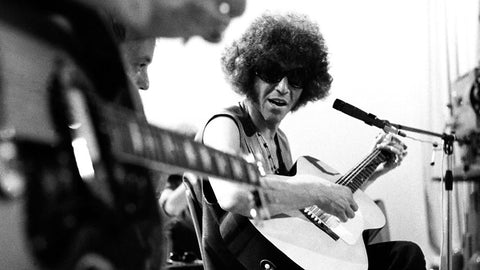\n\nSending a birthday shout-out to one of the fathers of British blues, **Alexis Korner**. He brought many artists to Britain to perform in the nightclubs from the '50s to the '70s. He also had slots on radio & TV to help bring American blues records and artists to the general public. But perhaps more importantly, he led bands that served as a school for young British blues-rockers.\n\nHe played guitar, piano and mandolin with several ensembles from the '40s and formed Blues Incorporated in '61. Membership in that collective group included a who's-who of great British soon-to-be rockers (and jazzers), including several future members of the Rolling Stones, Cream & Led Zeppelin not to mention the likes of John Mayall, Dick Heckstall-Smith, Rod Stewart, Graham Bond, Danny Thompson, Lol Coxhill, John Surman, Georgie Fame, Dave Holland, Paul Rodgers, Harry Beckett, Peter Frampton, Herbie Flowers and more. As such, he was long considered the elder statesman of the blues across the pond.",
"filePath": "content/posts/alexis-korner-april-19-1928-jan-1-1984.md",
"digest": "b6a39f7c5358c229",
"rendered": {
"html": "<p><img src=\"/images/p01bqqgk_large.jpg\" alt=\"\"></p>\n<p>Sending a birthday shout-out to one of the fathers of British blues, <strong>Alexis Korner</strong>. He brought many artists to Britain to perform in the nightclubs from the ’50s to the ’70s. He also had slots on radio & TV to help bring American blues records and artists to the general public. But perhaps more importantly, he led bands that served as a school for young British blues-rockers.</p>\n<p>He played guitar, piano and mandolin with several ensembles from the ’40s and formed Blues Incorporated in ‘61. Membership in that collective group included a who’s-who of great British soon-to-be rockers (and jazzers), including several future members of the Rolling Stones, Cream & Led Zeppelin not to mention the likes of John Mayall, Dick Heckstall-Smith, Rod Stewart, Graham Bond, Danny Thompson, Lol Coxhill, John Surman, Georgie Fame, Dave Holland, Paul Rodgers, Harry Beckett, Peter Frampton, Herbie Flowers and more. As such, he was long considered the elder statesman of the blues across the pond.</p>",
"metadata": {
"headings": [],
"localImagePaths": [],
"remoteImagePaths": [],
"frontmatter": {
"web-scraper-order": "1746561547-245",
"web-scraper-start-url": "https://peaceandrhythm.com",
"title": "Alexis Korner / April 19, 1928 - Jan 1, 1984",
"pagination": "https://www.peaceandrhythm.com/?page=63",
"date": "April 19, 2017",
"post": "Alexis Korner / April 19, 1928 - Jan 1, 1984",
"post-href": "https://www.peaceandrhythm.com/blogs/news/alexis-korner-april-19-1928-jan-1-1984",
"slug": "alexis-korner-april-19-1928-jan-1-1984"
},
"imagePaths": []
}
},
"collection": "blog"
},
{
"id": "bernie-worrell-april-19-1944-june-24-2016",
"data": {
"title": "Bernie Worrell / April 19, 1944 - June 24, 2016",
"slug": "bernie-worrell-april-19-1944-june-24-2016",
"date": "2017-04-19T00:00:00.000Z"
},
"body": "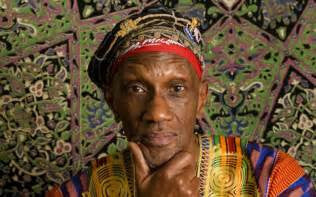\n\nClassically-trained keyboardist Bernie Worrell has his place established as a major innovator in the Funk with Parliament-Funkadelic, with whom he played from about 1970 into the early '80s, and contributing to projects of other members of the mob. He brought the Bach to the Funk. He spent the '80s as a member of the Talking Heads and beyond that found an incredible amount of creative work with superproducer Bill Laswell. In his later years he was a staple on the jamband scene with Les Claypool, Govt Mule and others.\n\nA musical prodigy from New Jersey, he was playing piano by 3 and wrote a concerto at 8. His early musical life was with the classical world, playing symphonic music. He studied at Julliard and the New England Conservatory. While at the Conservatory he was a member of the Cape Verdean R&B band that became Tavares. He joined up with George Clinton and The Parliaments and moved with them to Detroit. He was not only the keyboardist/synth player for the P-Funk empire, but also wrote and arranged several songs. He was a notable user of the Moog and the sounds of the music with it helped usher in the electro/techno age of black music. His first solo album, 1978's _All The Woo In The World_ , was backed by members of P-Funk.\n\nHe was with the Talking Heads in the '80s and worked on Mtume's smash hit \"Juicy Fruit\", as well as with Fred Schneider of the B-52s, Nona Hendryx, Golden Palominos and others. He was a major collaborator with Laswell, working with him on an astounding amount of records by the likes Material, Jah Wobble, Fela Kuti, Praxis, Sly & Robbie, Last Poets, Bootsy Collins, Manu Dibango, Afrika Bambaataa, Buckethead, Ginger Baker, Carlinhos Brown, Gigi, Lee Perry, Angélique Kidjo, Pharoah Sanders, Gil Scott-Heron, Touré Kunda, Aisha Kandisha's Jarring Effects, James Blood Ulmer, Yothu Yindi and several others.\n\nHis last two decades found him working on a lot of his own groups, as well as being a major draw at jamband festivals. He was a member of Claypool's ensembles and worked with Mos Def (Yasiin Bey), Prince Paul, Jack Bruce, Soulive and others, as well as his own Woo Warriors and the projects of several ex-P-Funkers. He passed away in 2016. His talents have graced more genres than just about anybody: funk, classical, gospel, death metal, dub, samba, out-jazz, jamband, new wave, hip-hop, techno, Afrobeat, ambient and just about everything else.",
"filePath": "content/posts/bernie-worrell-april-19-1944-june-24-2016.md",
"digest": "652a5faa5fbc12b6",
"rendered": {
"html": "<p><img src=\"/images/th_a3417226-d70f-49b6-a9f0-f67a56a9fa56_large.jpg\" alt=\"\"></p>\n<p>Classically-trained keyboardist Bernie Worrell has his place established as a major innovator in the Funk with Parliament-Funkadelic, with whom he played from about 1970 into the early ’80s, and contributing to projects of other members of the mob. He brought the Bach to the Funk. He spent the ’80s as a member of the Talking Heads and beyond that found an incredible amount of creative work with superproducer Bill Laswell. In his later years he was a staple on the jamband scene with Les Claypool, Govt Mule and others.</p>\n<p>A musical prodigy from New Jersey, he was playing piano by 3 and wrote a concerto at 8. His early musical life was with the classical world, playing symphonic music. He studied at Julliard and the New England Conservatory. While at the Conservatory he was a member of the Cape Verdean R&B band that became Tavares. He joined up with George Clinton and The Parliaments and moved with them to Detroit. He was not only the keyboardist/synth player for the P-Funk empire, but also wrote and arranged several songs. He was a notable user of the Moog and the sounds of the music with it helped usher in the electro/techno age of black music. His first solo album, 1978’s <em>All The Woo In The World</em> , was backed by members of P-Funk.</p>\n<p>He was with the Talking Heads in the ’80s and worked on Mtume’s smash hit “Juicy Fruit”, as well as with Fred Schneider of the B-52s, Nona Hendryx, Golden Palominos and others. He was a major collaborator with Laswell, working with him on an astounding amount of records by the likes Material, Jah Wobble, Fela Kuti, Praxis, Sly & Robbie, Last Poets, Bootsy Collins, Manu Dibango, Afrika Bambaataa, Buckethead, Ginger Baker, Carlinhos Brown, Gigi, Lee Perry, Angélique Kidjo, Pharoah Sanders, Gil Scott-Heron, Touré Kunda, Aisha Kandisha’s Jarring Effects, James Blood Ulmer, Yothu Yindi and several others.</p>\n<p>His last two decades found him working on a lot of his own groups, as well as being a major draw at jamband festivals. He was a member of Claypool’s ensembles and worked with Mos Def (Yasiin Bey), Prince Paul, Jack Bruce, Soulive and others, as well as his own Woo Warriors and the projects of several ex-P-Funkers. He passed away in 2016. His talents have graced more genres than just about anybody: funk, classical, gospel, death metal, dub, samba, out-jazz, jamband, new wave, hip-hop, techno, Afrobeat, ambient and just about everything else.</p>",
"metadata": {
"headings": [],
"localImagePaths": [],
"remoteImagePaths": [],
"frontmatter": {
"web-scraper-order": "1746561550-246",
"web-scraper-start-url": "https://peaceandrhythm.com",
"title": "Bernie Worrell / April 19, 1944 - June 24, 2016",
"pagination": "https://www.peaceandrhythm.com/?page=63",
"date": "April 19, 2017",
"post": "Bernie Worrell / April 19, 1944 - June 24, 2016",
"post-href": "https://www.peaceandrhythm.com/blogs/news/bernie-worrell-april-19-1944-june-24-2016",
"slug": "bernie-worrell-april-19-1944-june-24-2016"
},
"imagePaths": []
}
},
"collection": "blog"
},
{
"id": "clyde-stubblefield-april-18-1943-feb-18-2017",
"data": {
"title": "Clyde Stubblefield / April 18, 1943 - Feb 18, 2017",
"slug": "clyde-stubblefield-april-18-1943-feb-18-2017",
"date": "2017-04-18T00:00:00.000Z"
},
"body": "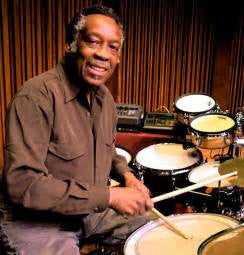\n\nThe recently-deceased **Clyde Stubblefield,** along with Jabo Starks, was one of the drummers in the James Brown band from '65-'70, powering \"Cold Sweat\", \"Ain't It Funky Now\", \"Say It Loud - I'm Black & I'm Proud\", \"There Was A Time\", \"Sex Machine\", \"I Got The Feelin\", \"Mother Popcorn\", \"Get Up Get Into It Get Involved\", Bobby Byrd's \"If You Don't Work, You Can't Eat\", Marva Whitney's \"It's My Thing\", Vicki Anderson's \"Message From The Soul Sisters\" and many more. _\"Starks was the Beatles to Clyde's Stones. A clean shuffle drummer to Clyde's free-jazz left hand\"_ \\--Questlove\n\nOf course, it's his drums on \"Funky Drummer\" that has been sampled HUNDREDS of times in hiphop, electronic and pop music. Yet Stubblefield, despite the fact that the song was built from scratch off of him jamming in the studio, did not get a composer credit, therefore no royalties or payment went to him.\n\nA native of Chatanooga TN, he was influenced by industrial sounds and trains. A self-taught drummer, he started his professional career as a teenager, playing with bluesman Eddie Kirkland and Otis Redding in the early '60s. He joined JB in '65, after James heard him in a club in Macon GA, and stayed until '70, when he moved briefly to Detroit and then settling in Madison WI in '71.\n\nHe remained in Madison for the rest of his life, holding a decades-long weekly residency with his own band. He also played locally and regionally in funk, jazz and country bands. He was the drummer for the nationally syndicated _Whad'ya Know?_ radio show. He also played with his former Brown bandmates from time to time, including Fred Wesley, Bootsy Collins, Maceo Parker, Pee Wee Ellis, as well as a partnership with Starks in The Funkmasters and other projects.\n\nAside from JB-related activities and all the samples, he can be heard drumming on albums by Ben Sidran, James Vincent (_Space Traveler_), Blume, Public Enemy, the P-Funk tribute band The Clinton Administration, Phil Upchurch, Stone Foundation, Bill O'Brien's _Cool At The Union_ , singer Hillary Smith, jazz guitarist Chris McDermott and Garbage. He also memorably appeared on _The Jimmy Fallon Show_ with The Roots and Chuck D.\n\nClyde largely stopped playing in 2011 when he got ill. To help raise money (and to rightly make some from his beats), he offered to play his JB beats for your record for a fee. Prince reportedly paid $90,000 worth of his medical bills. He passed in February.\n\nClyde showing how it's done:\n\nThe night James Brown saved Boston (after the MLK assassination), he gives the drummer some:\n\nStone classic!:\n\nSay it loud!\n\nWith Bobby Byrd:\n\nAnother James Brown alias: \"Steve Soul\":\n\nHere he is, puttin' in time with Phil Upchurch and Ben Sidran on Sidran's '73 album _Puttin' In Time On Planet Earth_ :\n\nFrom Sidran's '74 album _Don't Let Go_ :\n\nMadison-based band Blume, from their Mad City 45, ca '74:\n\nHere's a cut from Clyde's 1997 album _The Revenge of the Funky Drummer_ , also available on a 12\":",
"filePath": "content/posts/clyde-stubblefield-april-18-1943-feb-18-2017.md",
"digest": "4e6b4ddc93f732fc",
"rendered": {
"html": "<p><img src=\"/images/th_4e339d09-5920-4f05-811b-09de828720a3_large.jpg\" alt=\"\"></p>\n<p>The recently-deceased <strong>Clyde Stubblefield,</strong> along with Jabo Starks, was one of the drummers in the James Brown band from ‘65-‘70, powering “Cold Sweat”, “Ain’t It Funky Now”, “Say It Loud - I’m Black & I’m Proud”, “There Was A Time”, “Sex Machine”, “I Got The Feelin”, “Mother Popcorn”, “Get Up Get Into It Get Involved”, Bobby Byrd’s “If You Don’t Work, You Can’t Eat”, Marva Whitney’s “It’s My Thing”, Vicki Anderson’s “Message From The Soul Sisters” and many more. <em>“Starks was the Beatles to Clyde’s Stones. A clean shuffle drummer to Clyde’s free-jazz left hand”</em> —Questlove</p>\n<p>Of course, it’s his drums on “Funky Drummer” that has been sampled HUNDREDS of times in hiphop, electronic and pop music. Yet Stubblefield, despite the fact that the song was built from scratch off of him jamming in the studio, did not get a composer credit, therefore no royalties or payment went to him.</p>\n<p>A native of Chatanooga TN, he was influenced by industrial sounds and trains. A self-taught drummer, he started his professional career as a teenager, playing with bluesman Eddie Kirkland and Otis Redding in the early ’60s. He joined JB in ‘65, after James heard him in a club in Macon GA, and stayed until ‘70, when he moved briefly to Detroit and then settling in Madison WI in ‘71.</p>\n<p>He remained in Madison for the rest of his life, holding a decades-long weekly residency with his own band. He also played locally and regionally in funk, jazz and country bands. He was the drummer for the nationally syndicated <em>Whad’ya Know?</em> radio show. He also played with his former Brown bandmates from time to time, including Fred Wesley, Bootsy Collins, Maceo Parker, Pee Wee Ellis, as well as a partnership with Starks in The Funkmasters and other projects.</p>\n<p>Aside from JB-related activities and all the samples, he can be heard drumming on albums by Ben Sidran, James Vincent (<em>Space Traveler</em>), Blume, Public Enemy, the P-Funk tribute band The Clinton Administration, Phil Upchurch, Stone Foundation, Bill O’Brien’s <em>Cool At The Union</em> , singer Hillary Smith, jazz guitarist Chris McDermott and Garbage. He also memorably appeared on <em>The Jimmy Fallon Show</em> with The Roots and Chuck D.</p>\n<p>Clyde largely stopped playing in 2011 when he got ill. To help raise money (and to rightly make some from his beats), he offered to play his JB beats for your record for a fee. Prince reportedly paid $90,000 worth of his medical bills. He passed in February.</p>\n<p>Clyde showing how it’s done:</p>\n<p>The night James Brown saved Boston (after the MLK assassination), he gives the drummer some:</p>\n<p>Stone classic!:</p>\n<p>Say it loud!</p>\n<p>With Bobby Byrd:</p>\n<p>Another James Brown alias: “Steve Soul”:</p>\n<p>Here he is, puttin’ in time with Phil Upchurch and Ben Sidran on Sidran’s ‘73 album <em>Puttin’ In Time On Planet Earth</em> :</p>\n<p>From Sidran’s ‘74 album <em>Don’t Let Go</em> :</p>\n<p>Madison-based band Blume, from their Mad City 45, ca ‘74:</p>\n<p>Here’s a cut from Clyde’s 1997 album <em>The Revenge of the Funky Drummer</em> , also available on a 12”:</p>",
"metadata": {
"headings": [],
"localImagePaths": [],
"remoteImagePaths": [],
"frontmatter": {
"web-scraper-order": "1746561545-244",
"web-scraper-start-url": "https://peaceandrhythm.com",
"title": "Clyde Stubblefield / April 18, 1943 - Feb 18, 2017",
"pagination": "https://www.peaceandrhythm.com/?page=63",
"date": "April 18, 2017",
"post": "Clyde Stubblefield / April 18, 1943 - Feb 18, 2017",
"post-href": "https://www.peaceandrhythm.com/blogs/news/clyde-stubblefield-april-18-1943-feb-18-2017",
"slug": "clyde-stubblefield-april-18-1943-feb-18-2017"
},
"imagePaths": []
}
},
"collection": "blog"
},
{
"id": "lord-kitchener-april-18-1922-feb-11-2000",
"data": {
"title": "Lord Kitchener / April 18, 1922 - Feb 11, 2000",
"slug": "lord-kitchener-april-18-1922-feb-11-2000",
"date": "2017-04-18T00:00:00.000Z"
},
"body": "\n\nThe calypsonian Aldwyn Roberts became **Lord Kitchener** in 1945. He bumped around the Caribbean (including his native Trinidad, as well as Jamaica) before setting sail for the UK in '48, where he immediately hit with the classic \"London Is The Place For Me\".\n\nHe was a popular and important figure in the West Indian community that was starting to move to the UK in huge numbers. Kitch caught the wave of popularity that calypso rode in the '50s, even touring Africa. In '62 he was back in his homeland and he was one of the biggest Caribbean stars in the '60s & '70s.\n\nHe mentored up & coming young stars (including the first female Road March Winner, Calypso Rose). Kitch himself holds the record of ten such Road March victories, one of the highest honors in Trinidadian music competition. He was also the 1975 Calypso Monarch. He went soca in the late '70s and had a huge hit with \"Sugar Bum Bum\" in '78. He has been dubbed \"the Grand Master of Calypso\".",
"filePath": "content/posts/lord-kitchener-april-18-1922-feb-11-2000.md",
"digest": "3b8d4071e36d2e3b",
"rendered": {
"html": "<p><img src=\"/images/lord_kitchener_calypsonian_large.jpg\" alt=\"\"></p>\n<p>The calypsonian Aldwyn Roberts became <strong>Lord Kitchener</strong> in 1945. He bumped around the Caribbean (including his native Trinidad, as well as Jamaica) before setting sail for the UK in ‘48, where he immediately hit with the classic “London Is The Place For Me”.</p>\n<p>He was a popular and important figure in the West Indian community that was starting to move to the UK in huge numbers. Kitch caught the wave of popularity that calypso rode in the ’50s, even touring Africa. In ‘62 he was back in his homeland and he was one of the biggest Caribbean stars in the ’60s & ’70s.</p>\n<p>He mentored up & coming young stars (including the first female Road March Winner, Calypso Rose). Kitch himself holds the record of ten such Road March victories, one of the highest honors in Trinidadian music competition. He was also the 1975 Calypso Monarch. He went soca in the late ’70s and had a huge hit with “Sugar Bum Bum” in ‘78. He has been dubbed “the Grand Master of Calypso”.</p>",
"metadata": {
"headings": [],
"localImagePaths": [],
"remoteImagePaths": [],
"frontmatter": {
"web-scraper-order": "1746561538-243",
"web-scraper-start-url": "https://peaceandrhythm.com",
"title": "Lord Kitchener / April 18, 1922 - Feb 11, 2000",
"pagination": "https://www.peaceandrhythm.com/?page=64",
"date": "April 18, 2017",
"post": "Lord Kitchener / April 18, 1922 - Feb 11, 2000",
"post-href": "https://www.peaceandrhythm.com/blogs/news/lord-kitchener-april-18-1922-feb-11-2000",
"slug": "lord-kitchener-april-18-1922-feb-11-2000"
},
"imagePaths": []
}
},
"collection": "blog"
},
{
"id": "chief-bey-april-17-1913-april-8-2004",
"data": {
"title": "Chief Bey / April 17, 1913 - April 8, 2004",
"slug": "chief-bey-april-17-1913-april-8-2004",
"date": "2017-04-17T00:00:00.000Z"
},
"body": "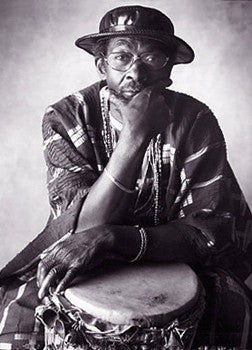\n\nThe Muslim-American multi-instrumentalist and folklorist **Chief Bey** contributed some heavy percussion to the ethno-jazz scene from the '50s until just weeks before his death in 2004. He was born James Hawthorne Bey in the area of Beaufort SC and grew up in Brooklyn & Harlem.\n\nIn the '50s he toured internationally in a production of _Porgy & Bess_ (with Cab Calloway and Leontyne Price. Around 1951 he cut his first session as a bandleader, although it was credited to \"Cawanda's group\" (the exotica cash-in LP _Taboo_). In '59 he appeared on Olatunji's Afro smash-hit record _Drums of Passion_ and went on to work and appear with 'Tunji and other such heavy cultural jazz cats as Guy Warren, Harry Belafonte, Herbie Mann, Art Blakey (his afro-percussion ensembles), Ahmed Abdul-Malik, Miriam Makeba, Solomon Ilori, Pharoah Sanders (check him on the classics _Thembi_ and _Izipho Zam_), Ray Barretto, the mystical psychedelic group Arica, guitarist Howard Roberts, Kwame Nkrumah, Plunky Branch & Okeryema Asante of Oneness of Juju, Randy Weston, World Saxophone Quartet and several collaborations with WSQ member Hamiet Bluiett.\n\nHe also recorded an album called _Congo Percussion_ with his own ensemble Chief Bey & His Royal Household. He recorded later albums for Soul Note and Mapleshade. Bey was a first call for authentic African percussion and his arsenal included asiko, shekere, congas, gongs, Batá, chanting and he even contributed a few original compositions to some of the above records. He appeared on Broadway a few times and even made on-screen appearances in the '90s Brooklyn-themed flicks _Smoke_ and _Blue In The Face_. A teacher and cultural heavy until the end, his music covered jazz, Afro-Cuban, African roots, new age, gospel and highlife musics.\n\nWith the scant few records under Bey's leadership easily available via Youtube, I've chosen this tune from Pharoah Sanders' classic _Thembi_ album. You can hear Bey as part of a battery of African percussionists:",
"filePath": "content/posts/chief-bey-april-17-1913-april-8-2004.md",
"digest": "7aed97eac4b0abaa",
"rendered": {
"html": "<p><img src=\"/images/Chief_Bey_large.jpg\" alt=\"\"></p>\n<p>The Muslim-American multi-instrumentalist and folklorist <strong>Chief Bey</strong> contributed some heavy percussion to the ethno-jazz scene from the ’50s until just weeks before his death in 2004. He was born James Hawthorne Bey in the area of Beaufort SC and grew up in Brooklyn & Harlem.</p>\n<p>In the ’50s he toured internationally in a production of <em>Porgy & Bess</em> (with Cab Calloway and Leontyne Price. Around 1951 he cut his first session as a bandleader, although it was credited to “Cawanda’s group” (the exotica cash-in LP <em>Taboo</em>). In ‘59 he appeared on Olatunji’s Afro smash-hit record <em>Drums of Passion</em> and went on to work and appear with ‘Tunji and other such heavy cultural jazz cats as Guy Warren, Harry Belafonte, Herbie Mann, Art Blakey (his afro-percussion ensembles), Ahmed Abdul-Malik, Miriam Makeba, Solomon Ilori, Pharoah Sanders (check him on the classics <em>Thembi</em> and <em>Izipho Zam</em>), Ray Barretto, the mystical psychedelic group Arica, guitarist Howard Roberts, Kwame Nkrumah, Plunky Branch & Okeryema Asante of Oneness of Juju, Randy Weston, World Saxophone Quartet and several collaborations with WSQ member Hamiet Bluiett.</p>\n<p>He also recorded an album called <em>Congo Percussion</em> with his own ensemble Chief Bey & His Royal Household. He recorded later albums for Soul Note and Mapleshade. Bey was a first call for authentic African percussion and his arsenal included asiko, shekere, congas, gongs, Batá, chanting and he even contributed a few original compositions to some of the above records. He appeared on Broadway a few times and even made on-screen appearances in the ’90s Brooklyn-themed flicks <em>Smoke</em> and <em>Blue In The Face</em>. A teacher and cultural heavy until the end, his music covered jazz, Afro-Cuban, African roots, new age, gospel and highlife musics.</p>\n<p>With the scant few records under Bey’s leadership easily available via Youtube, I’ve chosen this tune from Pharoah Sanders’ classic <em>Thembi</em> album. You can hear Bey as part of a battery of African percussionists:</p>",
"metadata": {
"headings": [],
"localImagePaths": [],
"remoteImagePaths": [],
"frontmatter": {
"web-scraper-order": "1746561531-241",
"web-scraper-start-url": "https://peaceandrhythm.com",
"title": "Chief Bey / April 17, 1913 - April 8, 2004",
"pagination": "https://www.peaceandrhythm.com/?page=64",
"date": "April 17, 2017",
"post": "Chief Bey / April 17, 1913 - April 8, 2004",
"post-href": "https://www.peaceandrhythm.com/blogs/news/chief-bey-april-17-1913-april-8-2004",
"slug": "chief-bey-april-17-1913-april-8-2004"
},
"imagePaths": []
}
},
"collection": "blog"
},
{
"id": "david-axelrod-april-17-1931-feb-5-2017",
"data": {
"title": "David Axelrod / April 17, 1931 - Feb 5, 2017",
"slug": "david-axelrod-april-17-1931-feb-5-2017",
"date": "2017-04-17T00:00:00.000Z"
},
"body": "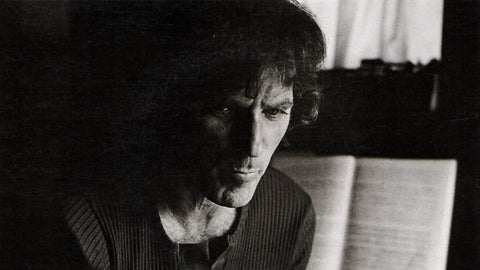\n\nBest known as a producer of sample-ready '60s records of unique vision, **David Axelrod** held many chairs in his career, from drummer to composer, A&R man and especially as a recording engineer, arranger and producer. In the late '60s and '70s he created several personal statements with his drum-heavy engineering, polished arrangements, creative use of strings, funky beats and eco-oriented themes. A longtime favorite of hip-hop samplers, his music was a groovy fusion of jazz, rock and soul. His sound and style is unmistakable to the ears.\n\nThe son of a union activist, he grew up in Los Angeles and took in the city's thriving jazz scene. Early on he worked in television and did some ring boxing before cutting sessions as a jazz drummer. He produced his first album in '59, _The Fox_ by saxophonist Harold Land, for the Hifi Jazz company. He worked for several West Coast jazz labels and became in demand as a skilled engineer before settling into his own creative projects. He notably worked with artists from the Electric Prunes to Lou Rawls to Letta Mbulu to Little Willie John and a longtime association with Cannonball Adderley.\n\nHe became a staff producer at Capitol in '63, working with Rawls, Adderley and others. He brought in a team of ringers (Carole Kaye, Earl Palmer and other \"Wrecking Crew\" folks) to replace the Electric Prunes for the classic _Release of an Oath._ In '69 and '69 he released his heady William Blake-inspired albums under his own name, _Songs of Innocence_ and _Songs of Experience,_ followed by 1970's Earth Day-oriented _Earth Rot_. A string of albums in the '70s were released on various labels (RCA/Decca, Fantasy, Polydor, MCA, etc). He also composed music for the _Sesame Street_ television show.\n\nHis '80s recordings were shelved and it wasn't until his re-discovery by the hiphop generation that his records started selling again and he made some new recordings for MoWax and others. In 2004 he was in full comeback mode, conducting his own work at the Royal Festival Hall. But he got ill for quite awhile and passed a couple months ago.",
"filePath": "content/posts/david-axelrod-april-17-1931-feb-5-2017.md",
"digest": "893051ce962e3877",
"rendered": {
"html": "<p><img src=\"/images/p01bqlcn_large.jpg\" alt=\"\"></p>\n<p>Best known as a producer of sample-ready ’60s records of unique vision, <strong>David Axelrod</strong> held many chairs in his career, from drummer to composer, A&R man and especially as a recording engineer, arranger and producer. In the late ’60s and ’70s he created several personal statements with his drum-heavy engineering, polished arrangements, creative use of strings, funky beats and eco-oriented themes. A longtime favorite of hip-hop samplers, his music was a groovy fusion of jazz, rock and soul. His sound and style is unmistakable to the ears.</p>\n<p>The son of a union activist, he grew up in Los Angeles and took in the city’s thriving jazz scene. Early on he worked in television and did some ring boxing before cutting sessions as a jazz drummer. He produced his first album in ‘59, <em>The Fox</em> by saxophonist Harold Land, for the Hifi Jazz company. He worked for several West Coast jazz labels and became in demand as a skilled engineer before settling into his own creative projects. He notably worked with artists from the Electric Prunes to Lou Rawls to Letta Mbulu to Little Willie John and a longtime association with Cannonball Adderley.</p>\n<p>He became a staff producer at Capitol in ‘63, working with Rawls, Adderley and others. He brought in a team of ringers (Carole Kaye, Earl Palmer and other “Wrecking Crew” folks) to replace the Electric Prunes for the classic <em>Release of an Oath.</em> In ‘69 and ‘69 he released his heady William Blake-inspired albums under his own name, <em>Songs of Innocence</em> and <em>Songs of Experience,</em> followed by 1970’s Earth Day-oriented <em>Earth Rot</em>. A string of albums in the ’70s were released on various labels (RCA/Decca, Fantasy, Polydor, MCA, etc). He also composed music for the <em>Sesame Street</em> television show.</p>\n<p>His ’80s recordings were shelved and it wasn’t until his re-discovery by the hiphop generation that his records started selling again and he made some new recordings for MoWax and others. In 2004 he was in full comeback mode, conducting his own work at the Royal Festival Hall. But he got ill for quite awhile and passed a couple months ago.</p>",
"metadata": {
"headings": [],
"localImagePaths": [],
"remoteImagePaths": [],
"frontmatter": {
"web-scraper-order": "1746561535-242",
"web-scraper-start-url": "https://peaceandrhythm.com",
"title": "David Axelrod / April 17, 1931 - Feb 5, 2017",
"pagination": "https://www.peaceandrhythm.com/?page=64",
"date": "April 17, 2017",
"post": "David Axelrod / April 17, 1931 - Feb 5, 2017",
"post-href": "https://www.peaceandrhythm.com/blogs/news/david-axelrod-april-17-1931-feb-5-2017",
"slug": "david-axelrod-april-17-1931-feb-5-2017"
},
"imagePaths": []
}
},
"collection": "blog"
},
{
"id": "henry-mancini-april-16-1924-june-14-1994",
"data": {
"title": "Henry Mancini / April 16, 1924 - June 14, 1994",
"slug": "henry-mancini-april-16-1924-june-14-1994",
"date": "2017-04-16T00:00:00.000Z"
},
"body": "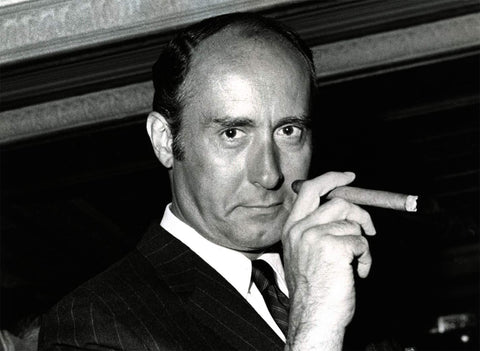\n\nThe Italian-American composer **Henry Mancini** has made an impression on my musical sensibilities in my early-eared days. Ever since I was a little kid one of my favorite tunes was the groovy _Pink Panther_ theme, with that silky sax by Plas Johnson. It was also hard to resist the theme to _Peter Gunn_(again, sax by Johnson). The soundtrack to Orson Welles' _Touch of Evil_ is another good one, as well as Mancini's great tune \"Baby Elephant Walk\". Personally, I can do without _Moon River_ and _Days of Wine & Roses_ but you got to hand it to the man for his large success, the scoring career he carved out as well as his ability to write in any style.\n\nCheck out the iconic unbroken opening scene from the Welles classic, featuring Mancini's music:",
"filePath": "content/posts/henry-mancini-april-16-1924-june-14-1994.md",
"digest": "f7a503b18dcd8a6b",
"rendered": {
"html": "<p><img src=\"/images/home-gallery-images-7_large.jpg\" alt=\"\"></p>\n<p>The Italian-American composer <strong>Henry Mancini</strong> has made an impression on my musical sensibilities in my early-eared days. Ever since I was a little kid one of my favorite tunes was the groovy <em>Pink Panther</em> theme, with that silky sax by Plas Johnson. It was also hard to resist the theme to <em>Peter Gunn</em>(again, sax by Johnson). The soundtrack to Orson Welles’ <em>Touch of Evil</em> is another good one, as well as Mancini’s great tune “Baby Elephant Walk”. Personally, I can do without <em>Moon River</em> and <em>Days of Wine & Roses</em> but you got to hand it to the man for his large success, the scoring career he carved out as well as his ability to write in any style.</p>\n<p>Check out the iconic unbroken opening scene from the Welles classic, featuring Mancini’s music:</p>",
"metadata": {
"headings": [],
"localImagePaths": [],
"remoteImagePaths": [],
"frontmatter": {
"web-scraper-order": "1746561526-239",
"web-scraper-start-url": "https://peaceandrhythm.com",
"title": "Henry Mancini / April 16, 1924 - June 14, 1994",
"pagination": "https://www.peaceandrhythm.com/?page=64",
"date": "April 16, 2017",
"post": "Henry Mancini / April 16, 1924 - June 14, 1994",
"post-href": "https://www.peaceandrhythm.com/blogs/news/henry-mancini-april-16-1924-june-14-1994",
"slug": "henry-mancini-april-16-1924-june-14-1994"
},
"imagePaths": []
}
},
"collection": "blog"
},
{
"id": "herbie-mann-april-16-1930-july-1-2003",
"data": {
"title": "Herbie Mann / April 16, 1930 - July 1, 2003",
"slug": "herbie-mann-april-16-1930-july-1-2003",
"date": "2017-04-16T00:00:00.000Z"
},
"body": "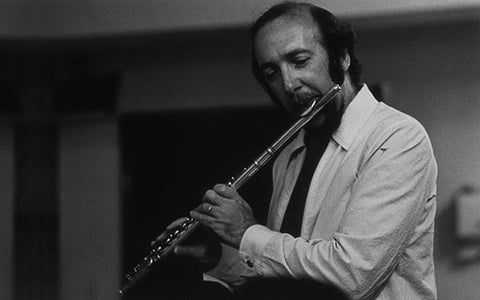\n\nWhen I was a teenager I was into all this crazy free jazz stuff (which I am still REALLY into, FYI) and someone like **Herbie Mann** seemed like a joke to me. His awful hairy-chested nudie album cover on _Push Push_ was disgusting to me and when a girl I knew (who was into the Grateful Dead...another band I hated in those years) expressed her fondness for both Herbie's \"physique\" and his music I gave her the album to take it off my hands. (I had bought it in a collection of jazz & blues albums).\n\nBut the problem with being an opinionated asshole snob, such as I was back in those days, was that if it wasn't some smoking and screaming Coltrane-inspired free jazz made by unknown black artists then I didn't take it seriously. Yeah, that's right, I was racist against white jazz musicians. And the fact that Mann's albums had a lot of cover tunes did nothing for me back then...it wasn't REAL jazz. It was just some hokey novelty boogaloo shit that shouldn't be taken seriously. Yes, being a teenager with a large grasp of music of avant-garde, punk, free jazz or socialist lyric variety really set me back on shit that makes the world go 'round: music you can dance to, smoke to, fuck to, or chill out to. But being the radical anti-fun shitbag rebellious (against teenagers!) teenager that I was, I had no desire to dance. What a jerk!\n\nBut now that I am an adult in my 40s I can honestly say that I was pretty much a piece of shit in those days with a disdain for anything that didn't scare the crap out of people. I think the only reason I got away with playing Sun Ra non-stop for partiers in my apartment was because I was the first kid to have my own apartment and if these kids wanted to congregate and drink, smoke, take acid, etc, my pad was a safe place to do so. So naturally I had to aid their trips with the sounds of Albert Ayler, Japanese noise, grindcore, Borbetomagus and other possibly unpleasant (to them) stuff. (Hey, some of them ended up turned ON to this shit!).\n\nAnyways...since Mann is the feature here I want to apologize to him for my honky-hating treatment towards him. As I got older and started to open my ears I could see that he has some excellent records. I mean really, had I known that he had Sonny Sharrock on some of those albums (check out the live set _Hold On, I'm Coming_ for a taste of Sonny going off on a Mann record) I would've given it more of a shot. Hell, his bands included favorites of mine like Ahmed Abdul-Malik, Bernard Purdie, Roy Ayers, Patato Valdez, Willie Bobo, Chick Corea, Al Jackson Jr and even collaborated in later years with Stereolab.\n\nIn '69 he started the Embryo label and produced some sides for Brute Force (another Sharrock-related item), Atilla Zoller's _Gyspy Cry_ , William S. Fischer's _Circles_ and an album by the great Kaw reedsman Jim Pepper. He also put out music by the very cool electronic pop project Tonto's Exploding Head Band. Also as a producer he worked on Dave Pike's _Doors of Perception_ and of course the ripping _Black Woman_ by Sonny Sharrock, a classic featuring the orgasmic Lynda Sharrock and the amazing percussionist Milford Graves! \n\nMann's own records covered a lot of ground culturally. He toured Africa in the late '50s and went to Brazil in '61 to further his studies. Best known on flute (although he played sax on occasion as well), he explored so many different types of music, from bossa to Middle Eastern to Latin to reggae to disco and yes...he actually did and could play real jazz. But he did put out some smooth jazz BS and crap-disco but that'll happen when you have 250 albums to your name and an eye on bringing something to the pop market.\n\nI definitely recommend checking out some of the '60s stuff on Atlantic with Sharrock and Ayers, you can find some of these records in thrift stores or the dollar bins. Mann had good and tasteful sidemen on his records and the best of the albums ranged from very hip fusions to groovy left-field cover versions of pop tunes. For starters check _At the Village Gate_ (a live date from '61), _Impressions of the Middle East_ ('67), the smash hit _Memphis Underground_ and _Stone Flute_ (both from '69) and the aforementioned _Hold On, I'm Coming_.\n\nI apologize for sharing personal info about my past, and sort of where I come from into the music. But I'll be honest - I am a much better person now than I was then, mostly because my ears are open and I don't take life so seriously. I STILL know people who are too cool for something that is un-serious and un-avantgarde and criticize the hell out of everyone and everything. Just fucken lighten up, man! Listen to some Mann! The moral of the story is...keep your damn ears open!",
"filePath": "content/posts/herbie-mann-april-16-1930-july-1-2003.md",
"digest": "09d1f140c5891821",
"rendered": {
"html": "<p><img src=\"/images/Herbie-Mann_large.jpg\" alt=\"\"></p>\n<p>When I was a teenager I was into all this crazy free jazz stuff (which I am still REALLY into, FYI) and someone like <strong>Herbie Mann</strong> seemed like a joke to me. His awful hairy-chested nudie album cover on <em>Push Push</em> was disgusting to me and when a girl I knew (who was into the Grateful Dead…another band I hated in those years) expressed her fondness for both Herbie’s “physique” and his music I gave her the album to take it off my hands. (I had bought it in a collection of jazz & blues albums).</p>\n<p>But the problem with being an opinionated asshole snob, such as I was back in those days, was that if it wasn’t some smoking and screaming Coltrane-inspired free jazz made by unknown black artists then I didn’t take it seriously. Yeah, that’s right, I was racist against white jazz musicians. And the fact that Mann’s albums had a lot of cover tunes did nothing for me back then…it wasn’t REAL jazz. It was just some hokey novelty boogaloo shit that shouldn’t be taken seriously. Yes, being a teenager with a large grasp of music of avant-garde, punk, free jazz or socialist lyric variety really set me back on shit that makes the world go ‘round: music you can dance to, smoke to, fuck to, or chill out to. But being the radical anti-fun shitbag rebellious (against teenagers!) teenager that I was, I had no desire to dance. What a jerk!</p>\n<p>But now that I am an adult in my 40s I can honestly say that I was pretty much a piece of shit in those days with a disdain for anything that didn’t scare the crap out of people. I think the only reason I got away with playing Sun Ra non-stop for partiers in my apartment was because I was the first kid to have my own apartment and if these kids wanted to congregate and drink, smoke, take acid, etc, my pad was a safe place to do so. So naturally I had to aid their trips with the sounds of Albert Ayler, Japanese noise, grindcore, Borbetomagus and other possibly unpleasant (to them) stuff. (Hey, some of them ended up turned ON to this shit!).</p>\n<p>Anyways…since Mann is the feature here I want to apologize to him for my honky-hating treatment towards him. As I got older and started to open my ears I could see that he has some excellent records. I mean really, had I known that he had Sonny Sharrock on some of those albums (check out the live set <em>Hold On, I’m Coming</em> for a taste of Sonny going off on a Mann record) I would’ve given it more of a shot. Hell, his bands included favorites of mine like Ahmed Abdul-Malik, Bernard Purdie, Roy Ayers, Patato Valdez, Willie Bobo, Chick Corea, Al Jackson Jr and even collaborated in later years with Stereolab.</p>\n<p>In ‘69 he started the Embryo label and produced some sides for Brute Force (another Sharrock-related item), Atilla Zoller’s <em>Gyspy Cry</em> , William S. Fischer’s <em>Circles</em> and an album by the great Kaw reedsman Jim Pepper. He also put out music by the very cool electronic pop project Tonto’s Exploding Head Band. Also as a producer he worked on Dave Pike’s <em>Doors of Perception</em> and of course the ripping <em>Black Woman</em> by Sonny Sharrock, a classic featuring the orgasmic Lynda Sharrock and the amazing percussionist Milford Graves!</p>\n<p>Mann’s own records covered a lot of ground culturally. He toured Africa in the late ’50s and went to Brazil in ‘61 to further his studies. Best known on flute (although he played sax on occasion as well), he explored so many different types of music, from bossa to Middle Eastern to Latin to reggae to disco and yes…he actually did and could play real jazz. But he did put out some smooth jazz BS and crap-disco but that’ll happen when you have 250 albums to your name and an eye on bringing something to the pop market.</p>\n<p>I definitely recommend checking out some of the ’60s stuff on Atlantic with Sharrock and Ayers, you can find some of these records in thrift stores or the dollar bins. Mann had good and tasteful sidemen on his records and the best of the albums ranged from very hip fusions to groovy left-field cover versions of pop tunes. For starters check <em>At the Village Gate</em> (a live date from ‘61), <em>Impressions of the Middle East</em> (‘67), the smash hit <em>Memphis Underground</em> and <em>Stone Flute</em> (both from ‘69) and the aforementioned <em>Hold On, I’m Coming</em>.</p>\n<p>I apologize for sharing personal info about my past, and sort of where I come from into the music. But I’ll be honest - I am a much better person now than I was then, mostly because my ears are open and I don’t take life so seriously. I STILL know people who are too cool for something that is un-serious and un-avantgarde and criticize the hell out of everyone and everything. Just fucken lighten up, man! Listen to some Mann! The moral of the story is…keep your damn ears open!</p>",
"metadata": {
"headings": [],
"localImagePaths": [],
"remoteImagePaths": [],
"frontmatter": {
"web-scraper-order": "1746561529-240",
"web-scraper-start-url": "https://peaceandrhythm.com",
"title": "Herbie Mann / April 16, 1930 - July 1, 2003",
"pagination": "https://www.peaceandrhythm.com/?page=64",
"date": "April 16, 2017",
"post": "Herbie Mann / April 16, 1930 - July 1, 2003",
"post-href": "https://www.peaceandrhythm.com/blogs/news/herbie-mann-april-16-1930-july-1-2003",
"slug": "herbie-mann-april-16-1930-july-1-2003"
},
"imagePaths": []
}
},
"collection": "blog"
}
]
Albert King / April 25, 1923 - Dec 21, 1992
April 25, 2017
Happy birthday to the great and influential bluesman Albert King , one of my all time favorites. I saw him play back in the '80s when I was a kid and it left a HUGE impression on me. A major guitar figure (who was a left-hander playing "backwards") and an...
Joe Henderson / April 24, 1937 - June 30, 2001
April 24, 2017
The great tenor saxophonist Joe Henderson came out of Wayne State University, where he was classmates with Yusef Lateef, Donald Byrd and Barry Harris. After leaving the Army in '62 he went to NYC and hooked up with Kenny Dorham & Dexter Gordon and then joined Horace Silver's group, soloing...
Johnny Griffin / April 24, 1928 - July 25, 2008
April 24, 2017
The speed metalist of the hard bop saxophone players, the tenor runs of Johnny Griffin could waste most competitors and his stretch in the '50s/early '60s with Blue Note, Riverside and Jazzland is hard to beat. He co-led a band with Eddie "Lockjaw" Davis and was a memorable feature with...
Louis Barron / April 23, 1920 - Nov 1, 1989
April 23, 2017
** Louis Barron together wit his wife Bebe were early pioneers of American electronic music and created the film score for MGM's awesome 1956 Sc-Fi flick Forbidden Planet. The "electronic tonalities" of the soundtrack made it the world's first entirely electronic film score. Louis Barron was an electrician who custom-built...
Roy Orbison / April 23, 1936 - Dec 6, 1988
April 23, 2017
One of early rock & roll's greatest voices, Roy Orbison , was born 80 years ago today. Mixing country, rockabilly and pop with meticulous recording and deep lyrics with that amazing voice, there was only one Roy Orbison, the man who dressed in black with dyed black hair and dark...
Charles Mingus / April 22, 1922 - Jan 5, 1979
April 22, 2017
** Charles Mingus , along with Israel "Cachao" Lopez and William Parker, are my favorite bassists of all time. Add that Mingus is one of the greatest composers to ever walk the planet and his notoriously prickly personality and you have a genuine one-of-a-kind icon of insane genius. Deeply bluesy,...
Joe Cuba / Aoril 22, 1931 - Feb 15, 2009
April 22, 2017
Despite the working name of "Joe Cuba ", the conguero Gilberto Calderon was actually a Nuyorican who grew up in Spanish Harlem. Since the first album in 1962 and into the '70s, the Joe Cuba Sextet were a very important and influential band on the newer generation of Latino musicians....
Paul Chambers / April 22, 1935 - Jan 4, 1969
April 22, 2017
The great jazz bass virtuoso Paul Chambers , forever immortalized by his old pal John Coltrane as "Mr PC", brought the instrument to a new level in his very short time on the planet. He was an early popularizer of the bowing technique and contributed greatly to harmonic advancement for...
Peter Kowald / April 21, 1944 - Sept 21, 2002
April 21, 2017
A favorite of many on the instrument, the much-missed Peter Kowald was a major league improvising bassist. He was a member of Globe Unity Orchestra, Cooperative Trio, his "world music" project Global Village, London Jazz Composers Orchestra, Schlippenbach Trio and many others. A native of Germany, he started playing in...
Beaver Harris / April 20, 1936 - Dec 22, 1991
April 20, 2017
One of the heaviest drummers in jazz, William "Beaver" Harris came out of a baseball family in Pittsburgh (in fact, his father was a founder of the Negro Leagues Pittsburgh team and two of Harris' uncles were pro players as well). A teenaged Beaver played professionally at 3B for the...
Lionel Hampton / April 20, 1908 - Aug 31, 2002
April 20, 2017
The great jazz vibraphonist & popular bandleader Lionel Hampton came out of Chicago and was a kit drummer before switching to a newly created instrument, the vibraphone, of which Hamp became the instrument's first star, his first gig on it being with Louie Armstrong in 1930. In the late '30s...
Tito Puente / April 20, 1923 - June 1, 2000
April 20, 2017
Happy 4/20 birthday shout-out to the iconic Tito Puente! Best known as a Simpsons charact...haha just kidding! Among the Nuyorican musical greats, there has never been a dull moment with El Rey's brand of fiery and entertaining Latin jazz. His first notable pro gig was with Machito during WW2, before...
Alexis Korner / April 19, 1928 - Jan 1, 1984
April 19, 2017
Sending a birthday shout-out to one of the fathers of British blues, Alexis Korner. He brought many artists to Britain to perform in the nightclubs from the '50s to the '70s. He also had slots on radio & TV to help bring American blues records and artists to the general...
Bernie Worrell / April 19, 1944 - June 24, 2016
April 19, 2017
Classically-trained keyboardist Bernie Worrell has his place established as a major innovator in the Funk with Parliament-Funkadelic, with whom he played from about 1970 into the early '80s, and contributing to projects of other members of the mob. He brought the Bach to the Funk. He spent the '80s as...
Clyde Stubblefield / April 18, 1943 - Feb 18, 2017
April 18, 2017
The recently-deceased Clyde Stubblefield, along with Jabo Starks, was one of the drummers in the James Brown band from '65-'70, powering "Cold Sweat", "Ain't It Funky Now", "Say It Loud - I'm Black & I'm Proud", "There Was A Time", "Sex Machine", "I Got The Feelin", "Mother Popcorn", "Get Up...
Lord Kitchener / April 18, 1922 - Feb 11, 2000
April 18, 2017
The calypsonian Aldwyn Roberts became Lord Kitchener in 1945. He bumped around the Caribbean (including his native Trinidad, as well as Jamaica) before setting sail for the UK in '48, where he immediately hit with the classic "London Is The Place For Me". He was a popular and important figure...
Chief Bey / April 17, 1913 - April 8, 2004
April 17, 2017
The Muslim-American multi-instrumentalist and folklorist Chief Bey contributed some heavy percussion to the ethno-jazz scene from the '50s until just weeks before his death in 2004. He was born James Hawthorne Bey in the area of Beaufort SC and grew up in Brooklyn & Harlem. In the '50s he toured...
David Axelrod / April 17, 1931 - Feb 5, 2017
April 17, 2017
Best known as a producer of sample-ready '60s records of unique vision, David Axelrod held many chairs in his career, from drummer to composer, A&R man and especially as a recording engineer, arranger and producer. In the late '60s and '70s he created several personal statements with his drum-heavy engineering,...
Henry Mancini / April 16, 1924 - June 14, 1994
April 16, 2017
The Italian-American composer Henry Mancini has made an impression on my musical sensibilities in my early-eared days. Ever since I was a little kid one of my favorite tunes was the groovy Pink Panther theme, with that silky sax by Plas Johnson. It was also hard to resist the theme...
Herbie Mann / April 16, 1930 - July 1, 2003
April 16, 2017
When I was a teenager I was into all this crazy free jazz stuff (which I am still REALLY into, FYI) and someone like Herbie Mann seemed like a joke to me. His awful hairy-chested nudie album cover on Push Push was disgusting to me and when a girl I...
